

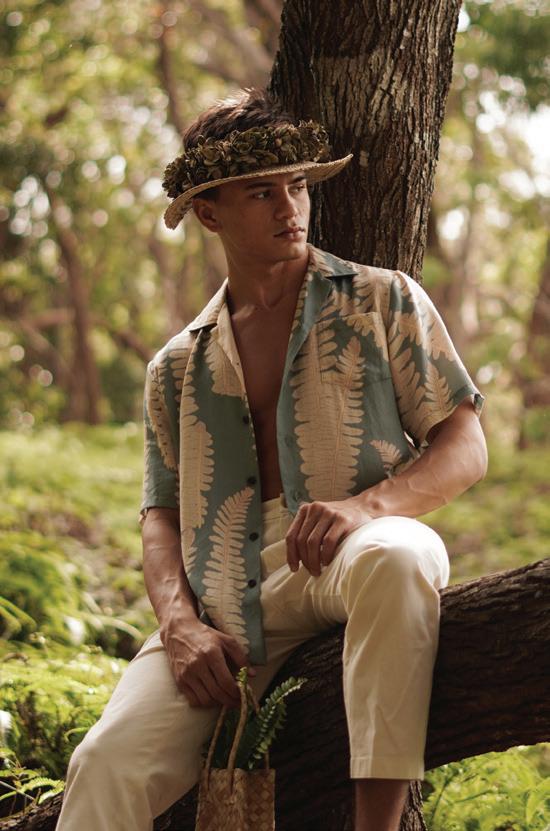
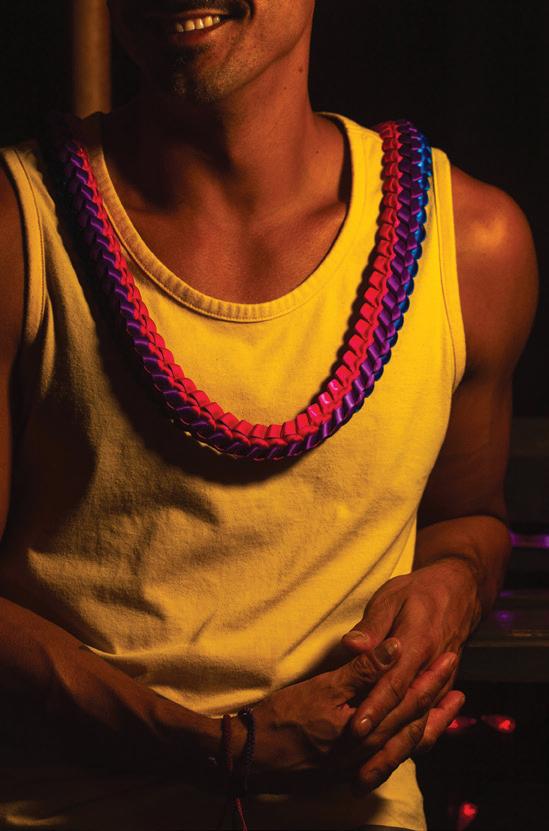
$14.95 $14.95 WASHINGTON, DC LONDON SAN FRANCISCO BALI
A
symbol of love, friendship, appreciation, and aloha.
For generations, the people of Hawai‘i have used lei to express these emotions, strengthen relationships, and show gratitude. Our roots are set in the islands and, as in the human gesture of gifting someone a lei, extend outward.
FOR THE LGBTQ TRAVELER


Hermes
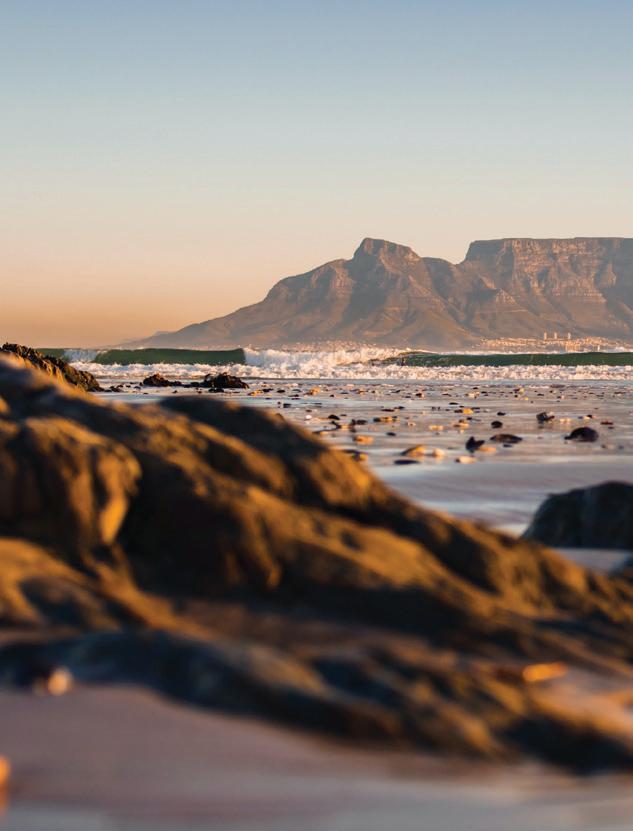
Hermes

With its natural wonders and cultural experiences, Cape Town, South Africa, is one of the most beautiful cities in the world that welcomes LGBTQ travelers. See more recommended escapes on page 106.
Photo: Janan Lagerwall
President & CEO
JASON CUTINELLA
Publisher Partner/GM - Hawai‘i
JOE V. BOCK
Editor-In-Chief
VP Global Brand Storytelling
MARC GRASER
Global Editorial Director
BRIAN MCMANUS
Editorial Director
LAUREN MCNALLY
Editorial Video Director, Hawai‘i
MATTHEW DEKNEEF
Managing Editor
EUNICA ESCALANTE
Senior Editor
RAE SOJOT
Managing Designer
TAYLOR NIIMOTO
Designers
ELEAZAR HERRADURA
COBY SHIMABUKURO-SANCHEZ
Senior Photographer
JOHN HOOK
Contributors
BRANDON BERNALDES
LESLIE DAM
EDDIE KIM
MITCHELL KUGA
LAUREN MCNALLY
NICCOLO SERRATT
Images
VINCENT BERCASIO
TAYLOR CULLEN
HARRY DAVIS
CHRISTINE DIAZ
LORENA GHEORGHE
GUNJ GUGLANI
ADAM NATHANIEL FURMAN
ERICA JOAN
HAWKEYE JOHNSON
KAIWEN NAINOA WANG NOBRIGA
MATT MILLER
NATALYA AL OMARY
KIRSTIE PIKE
DRAEDON SAYABOC
Digital Content & Social Media Manager
BRIGID PITTMAN
Digital Production Designer
ARRIANA VELOSO
VP Film
GERARD ELMORE
Filmmakers
BLAKE ABES
ROMEO LAPITAN
ERICK MELANSON
Video Editor
JHANTE IGA
Studio Director/Producer
KAITLYN LEDZIAN
Brand Production Coordinator
TAYLOR KONDO
VP Sales
MIKE WILEY
mike@nmgnetwork.com
Senior Director, Sales
ALEJANDRO MOXEY
Integrated Marketing Lead
FRANCINE NAOKO BEPPU
Client Services Director
KRISTINE PONTECHA
People and Creative Services Director
SHERI SALMON
Operations Director
SABRINE RIVERA
VP Accounts Recievable
GARY PAYNE
Sales Inquiries SALES@NMGNETWORK.COM
Published by 36 N. Hotel St., Suite A Honolulu, HI 96817 nmgnetwork.com
©2023 NMG Network. All rights reserved. No part of this publication may be reprinted without the written consent of the publisher. Opinions are solely those of the contributors and are not necessarily endorsed by NMG.
ISSN 2578-210X
MASTHEAD
6

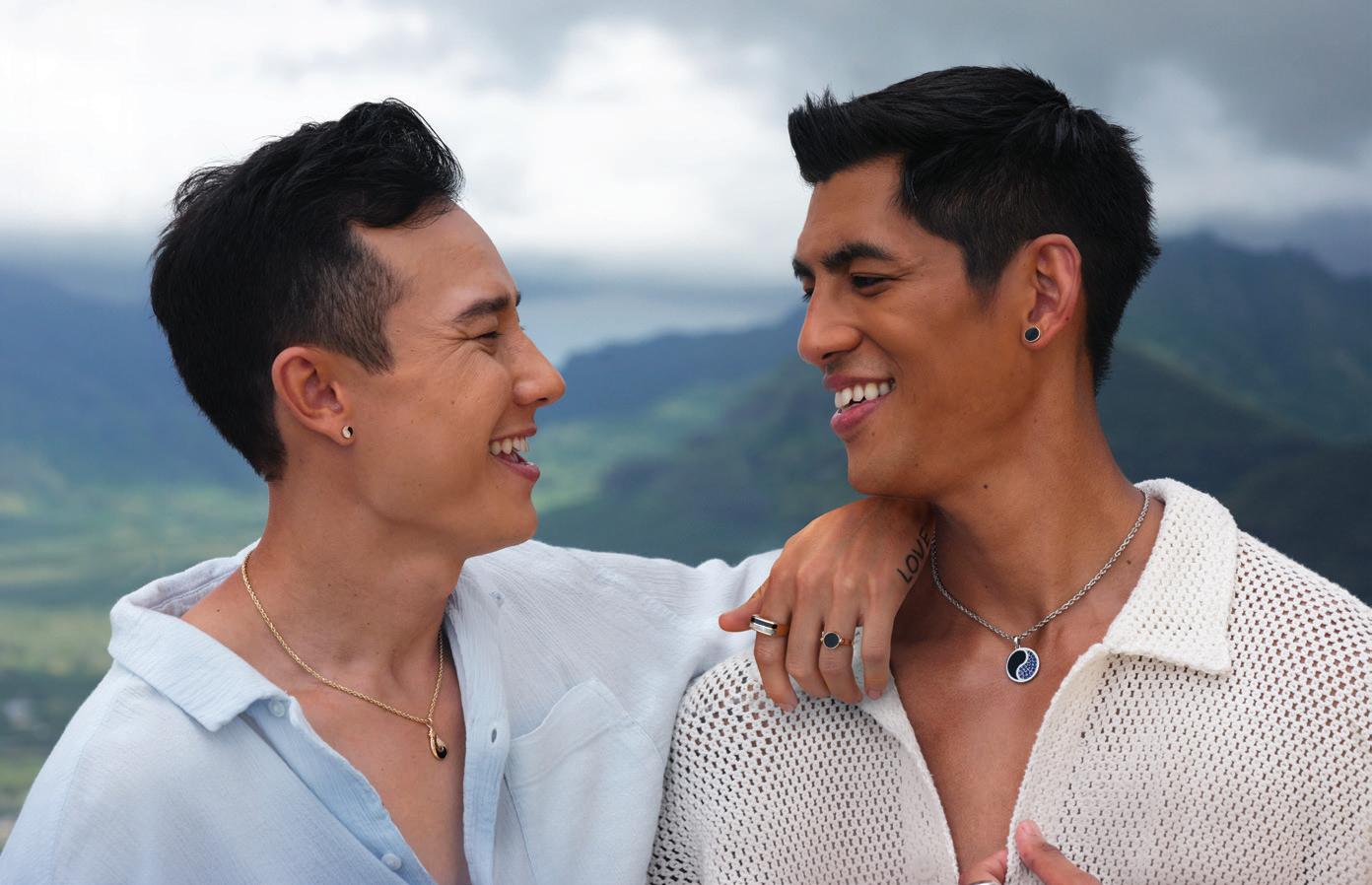
O‘ahu | Maui | Big Island | Kaua‘i | MauiDivers.com
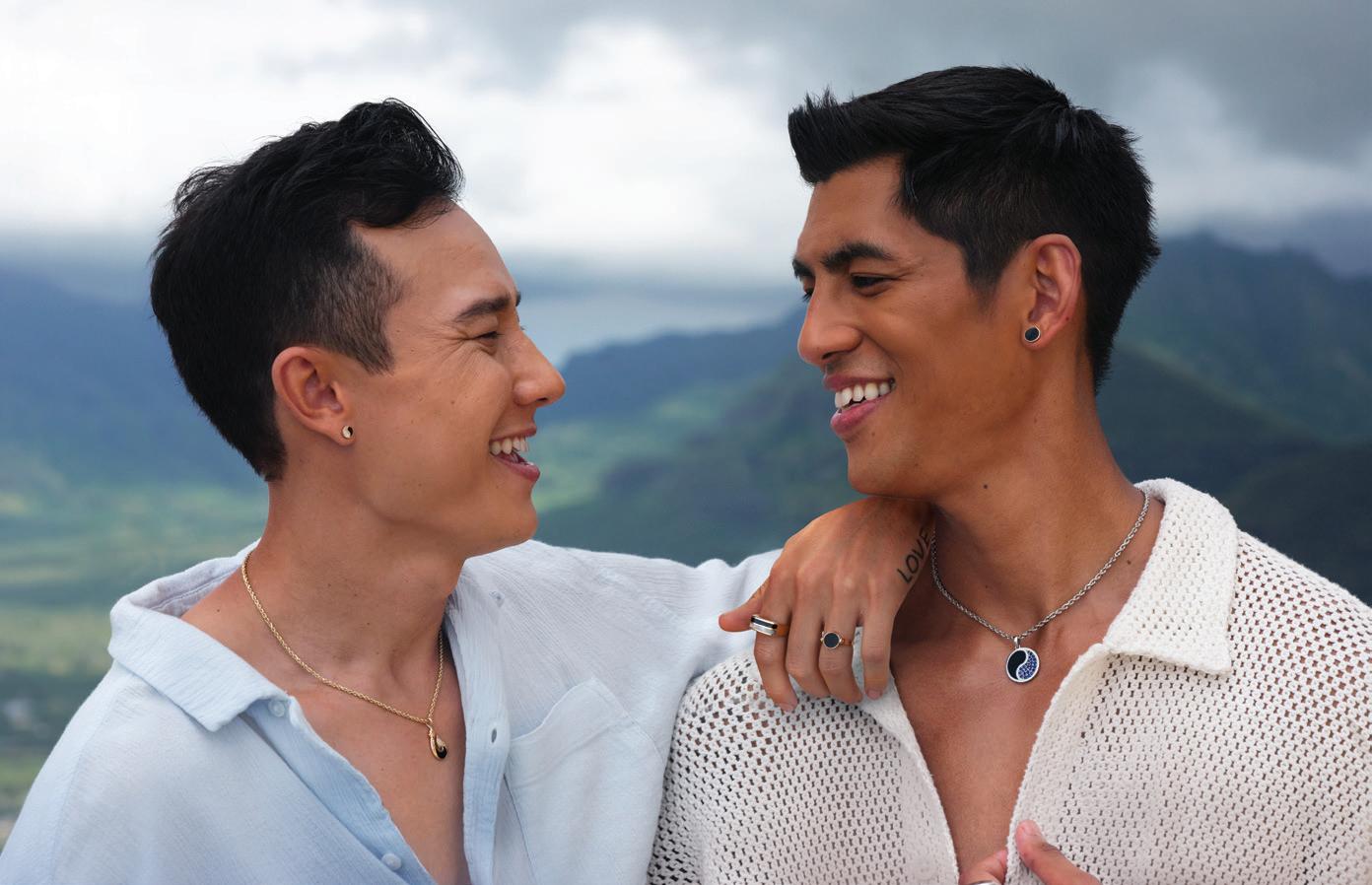
COMMUNITY
CULTURE
EXPLORE
22
PASSION FOR PRIDE
One photographer’s profound journey of self-discovery at Honolulu Pride.
36
EXQUISITE BLOOMS
A luxury florist finds family while showcasing the artistry of Japanese farmers.
44
SCENTS OF PLACE
An architect fascinated by the world of fragrances captures the essence of a place.
52
COFFEE CONNECTION
How two queer women found each other and chose to navigate a rapidly changing industry.
60
WHERE LGBTQ TRAVELERS SHOULD BE SEEN
Why hotels are a microcosm of acceptance and equality.
66
QUEER SPACES
Adam Nathaniel Furman offers historical narratives of queer havens.
74
CRACKING JOKES
San Diego’s crankiest drag queen spills party stories from Aspen Gay Ski Week.
80
SIP AND STAY
CASS Winery is proving as extroverted as it’s elegant.
88
BOTANICALLY INSPIRED
Horticulturist-turned-fashion designer David Shepard’s biggest muse.
96
DESTINATION BY DESIGN
How illustrator Matt Miller helps architects capture the look of Washington, DC and Tampa.
106
FIVE GREAT ESCAPES
Unique places queer travelers should consider when planning future trips.
120
ESTABLISHING RESIDENCY
Hospitality comes naturally for the founders of this Washington, DC eatery.
128
COUPLE CONNECTION
Newlywed photographers Leslie and Tanner Dam love a stunning backdrop.
136
FINDING LOVE IN ALL PLACES
The creators of On Airplane Mode inspire the LGBTQ community to travel safely.
TABLE OF CONTENTS 10


Lei TV offers a curated guide to Hawai‘i and other welcoming destinations for the discerning LGBTQ traveler. Its episodic series share diverse stories about the places, passions, and people who make the world unique and worth exploring.
Community
“Travel is important because you only go as far as you can see in life; unless you see or experience another culture, you are confined by what you know,” says Dakota Adan, an actor, model and dancer, who has a passion for travel and explored Honolulu and the island of O‘ahu with Lei, Alaska Airlines and his husband Dariusz for an episode of Lei Escapes. The two met while in Bali, and now live in Los Angeles, where they opened a photography studio. “That next ticket could be how you live the love of your life.”
Culture
Enter Gray Malin’s dog friendly world and discover how the whimsical photographer inspires wanderlust with his cheekily joyful travel images. How he got his start might surprise you.
Explore
When traveling is your calling, the feeling of loneliness, the need for companionship and the idea of settling isn’t too far behind for Barcelonabased flight attendant Niccolo Serratt.
12
ONLINE Discover stories that celebrate LGBTQ communities online at leiculture.com WATCH ONLINE AT: nmgnetwork.com/leitv instagram: @leiculture twitter: @leiculture facebook: /leiculture
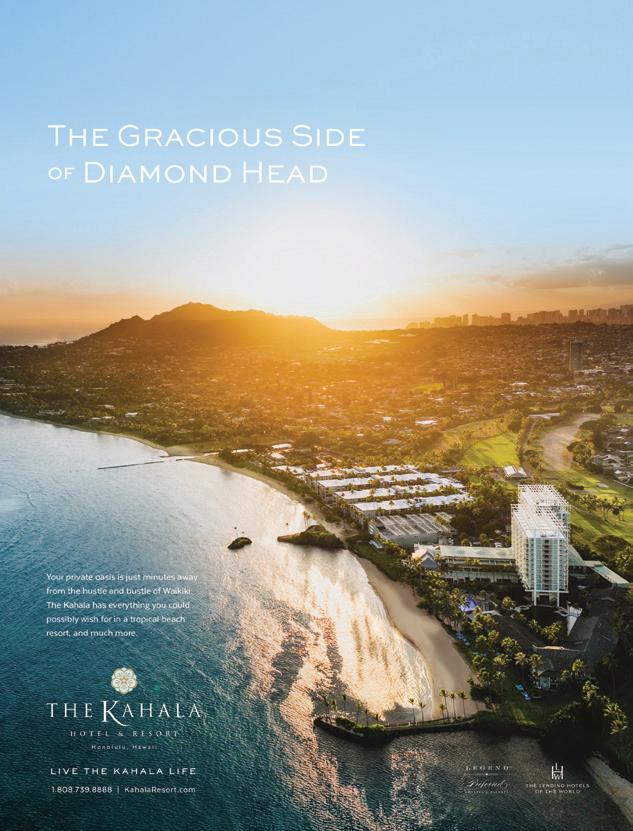
The world is a far more fascinating place if you’re a curious person. When we approach travel with an open mind, we embrace the unfamiliar and eagerly seek new experiences. Curiosity pushes us to explore hidden gems, immerse ourselves in diverse cultures, and engage with local customs. It sparks conversations with strangers, inspiring meaningful connections and broadens our worldview. By delving into the histories and stories of communities, we gain a deeper appreciation for their uniqueness— and ourselves as individuals.
Ultimately, curiosity fuels the sense of wonder that makes travel a transformative and unforgettable adventure, igniting our spirits as we discover the beauty and complexity of the world around us.
If there’s a theme in this year’s print edition of Lei, it’s the curiosity that drives the inspiring individuals we feature, and how it guides the decisions they make, and how they live their lives to the fullest.
They are all queer role models and respected members of their communities in Aspen, Honolulu, London, Los Angeles, Paso Robles, New York City, San Diego, San Francisco, Tampa, and Washington, DC.
From Carlos Huber, who created the signature scent of St. Regis Hotels & Resorts; to Helen Russell and Brooke McDonnell, the founders of Equator Coffees; and Kirstie Pike
and Christine Diaz, the power couple behind On Airplane Mode, everyone we meet in this issue is passionate about travel because it made them better people.
Each one of them represents that spirit of aloha Lei seeks out to celebrate and share with others.
Other places we visit in this issue include Amman, Jordan; Cape Town, South Africa; Kyoto, Japan; Mexico City; Paris and Portugal’s Algarve region with one goal in mind: how to experience some of the world’s most exciting and welcoming destinations.
Keep visiting LeiCulture.com and watch Lei TV series like The Lei Over, Lei Escapes, Lei Exchanges and City Pride for stories that will help you travel better and enable you to be your most sincere and authentic self.
Whatever makes you want to explore and see the world, remember to travel safe. And always travel proud.
Marc Graser Editor-in-Chief, Lei
@leiculture LeiCulture.com
reading Lei,
for
LGBTQ
LETTER FROM THE EDITOR 14
Aloha, and mahalo for
our voice
the
traveler.
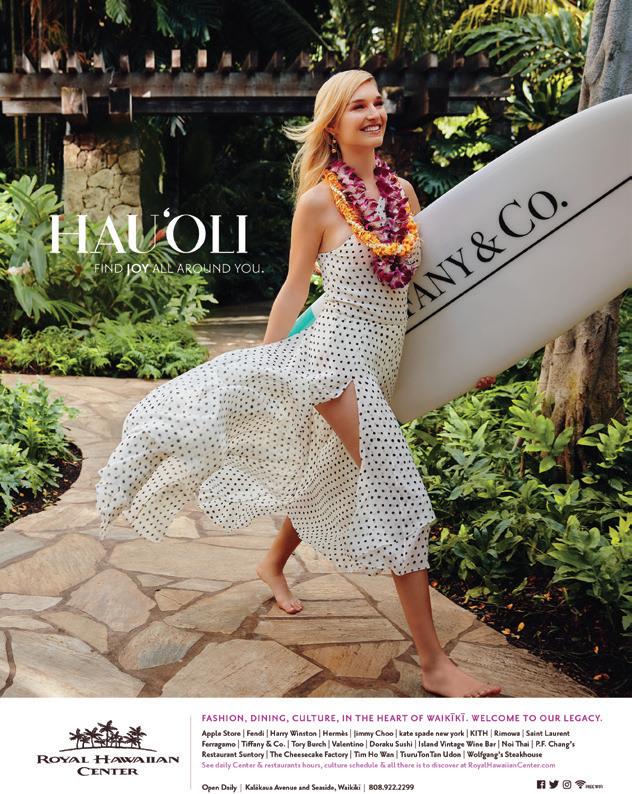




Now based in Honolulu after working in Los Angeles as a writer’s assistant on season eight of Showtime's “Homeland,” and a production coordinator on the network's documentary, “The Longest War,” about the U.S.’ involvement in Afghanistan, Natalya Al Omary is a photographer for Slapp Radio, and DJ. They photographed the 2022 Honolulu Pride Festival for this issue. “As a Middle Eastern, non-binary raised in Dubai, my hope is to continue to evolve and inspire others to embrace their true selves, fostering a celebration of our differences through art, travel, and the power of human connection,” Natalya says.
Eddie Kim is a journalist based in San Francisco, California, and was most recently a features writer with MEL Magazine, covering stories on masculinity, identity and social conflict. His work has also been published in VICE, Slate and The Guardian. He profiled the founders of Equator Coffee and CASS Winery for this issue.
Mitchell Kuga, who profiled the founder of luxury florist Gentle Beast in this issue, is a freelance journalist from Honolulu, Hawai‘i, where he currently lives with his husband Adam and his dog Diesel Kau Kau Lexapro Kuga. His work has appeared in GQ, Billboard, T Magazine, and Condé Nast Traveler, among others, and he is a recipient of the Excellence in Online Journalism Award from NLGJA: The Association of LGBTQ Journalists. Photo by Akilah Callahan.
Niccolo Serratt, who spent time with scents maker Carlos Huber and “Queer Spaces”-author Adam Nathaniel Furman, is a Barcelona-based freelance writer, he embodies the spirit of curiosity and adventure. When he’s not immersed in the vibrant streets of Barcelona, Niccolo’s insatiable wanderlust takes him to far-flung corners of the world, seeking out untrodden paths and hidden treasures. He is a dedicated LGBTQ+ activist that strives to make a positive impact and empower marginalized communities through his articles.
CONTRIBUTORS
NATALYA AL OMARY
EDDIE KIM
MITCHELL KUGA
NICCOLO SERRATT
16
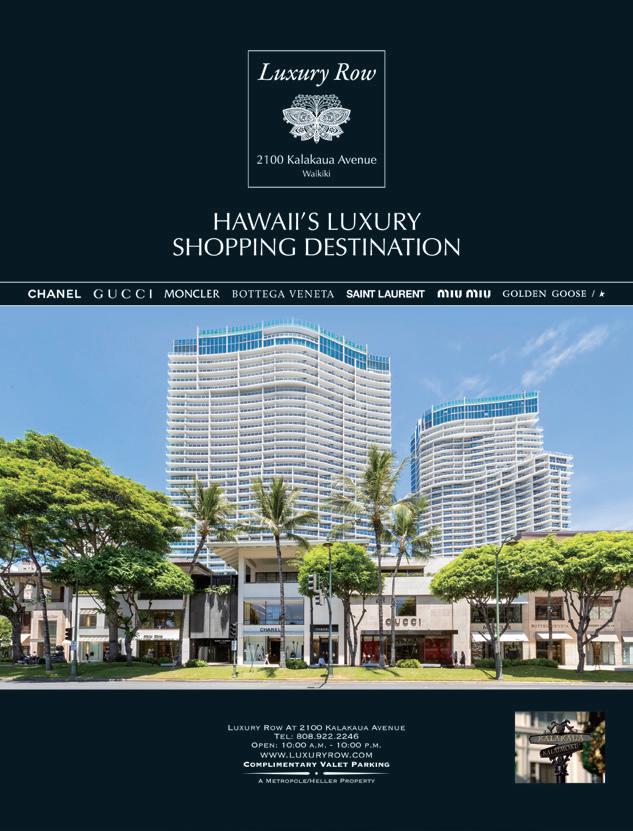

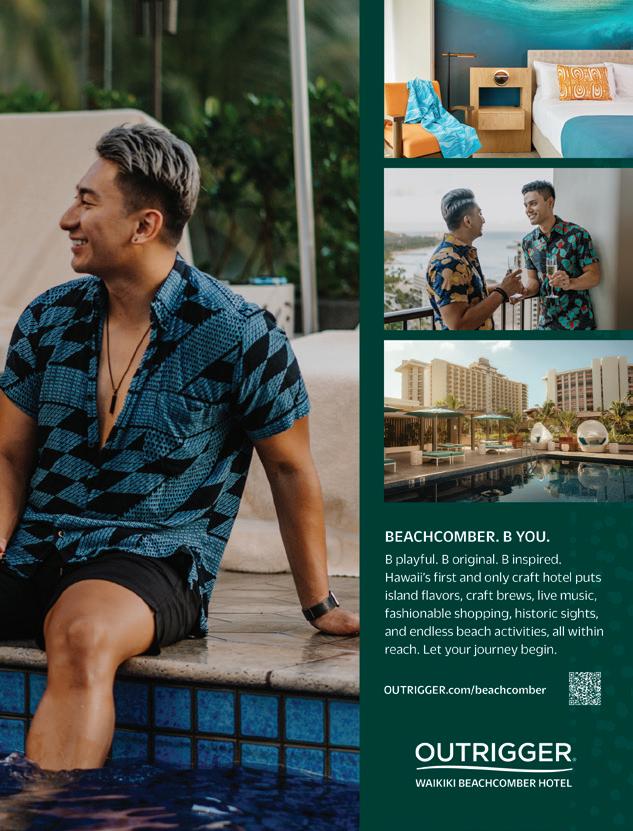
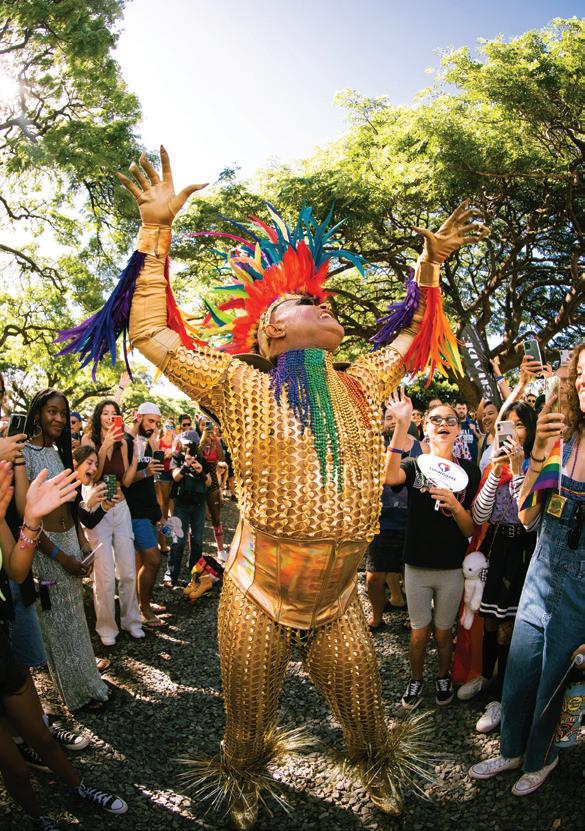
I. Community
Face to face with
those who hope to open up the conversation on identity and community
As a Middle Eastern, non-binary raised in Dubai, one photographer’s journey has been a profound exploration of selfdiscovery that’s reflected in images captured during Honolulu Pride.
Natalya Al Omary is a reason why we celebrate Pride.
“Honolulu Pride was the first pride after I came out as non-binary,” says Natalya, who identifies as they/them. “It was a celebration of being myself, finally, at 26.”
Originally from Syria, Natalya grew up in Dubai, which is not particularly known for its LGBT-friendly policies. “I’ve met people from all walks of life, but in terms of the LGBTQ community, it’s not talked about at all,” Natalya says.
After studying film at SAE, a university for the creative arts, and a brief stint in Richmond, Virginia, where Natalya has family, they ended up in Los Angeles to work in the entertainment industry. Shortly after landing jobs as a writer’s assistant on Showtime’s hit series “Homeland,” and becoming a production coordinator on a documentary about the U.S.’ involvement in Afghanistan, now America’s longest war, Covid shut the world down.
“Production in L.A. was dead; Nothing was happening,” Natalya says. A friend in Hawai‘i came calling, and what was supposed to be a month-long trip in March 2020 turned into a new home. “I’m still here.”
Natalya didn’t know anyone and didn’t have a job when they made the decision to move to Honolulu. “Yeah. I just kind of did it without thinking about it too much.”
Attending their first Pride in San Francisco, in 2018, was life changing, especially for someone who hadn’t been able to discuss their queerness through their childhood and teenage years. “I felt like I was dreaming the whole time,” Natalya recalls. “I wouldn’t have thought in a million years I would be able to just be open and myself. I actually met my first love there.”
When Slapp Radio gave Natalya, who also DJs, the opportunity to document Honolulu Pride, in 2020, with Romanian photographer Lorena Gheorghe, Natalya didn’t take much convincing.
“It was the first Pride that I was photographing, and the first Pride after coming out, as well, so the first Pride that I was kind of like, part of,” Natalya says. “It was kind of like a real celebration.”
WORDS BY MARC GRASER IMAGES
BY NATALYA AL OMARY AND LORENA GHEORGHE
PASSION FOR PRIDE 22

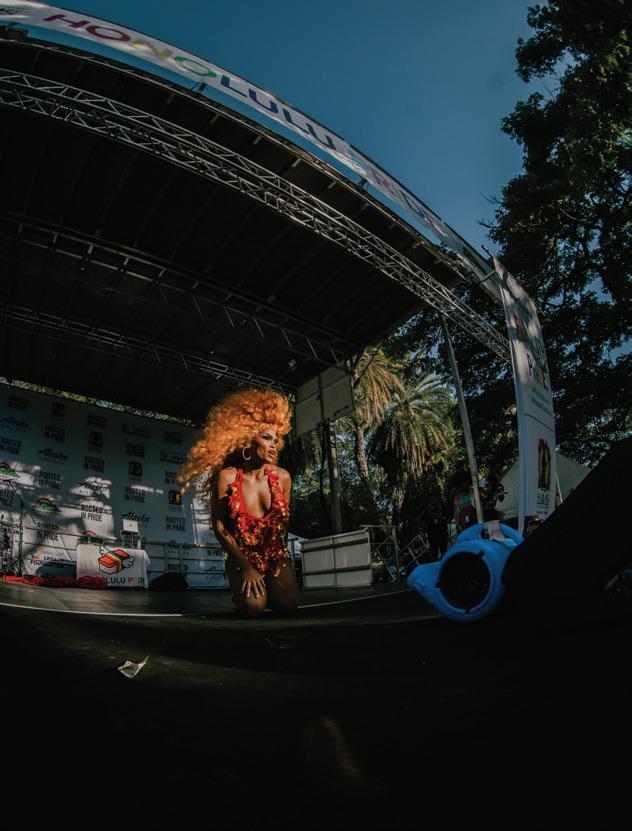
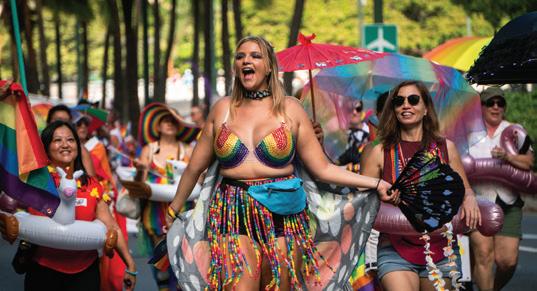
It wasn’t until moving to Honolulu that Natalya decided to cut their hair short and come out to everyone around them. Honolulu Pride amplified everything. Pride in Hawai‘i just hits different.
“It was so easy because everyone was just so happy,” Natalya says. “I wanted to take photos of everything.”
Natalya says Honolulu Pride “felt like it was 10 times more special because I feel like I was finally outside of my shell. I felt a change in me. There was something in the air; everyone was on the same wavelength of understanding each other. We didn’t need to explain anything to anyone. We were just being. Without even explaining who I was, people saw who I was.
“You see how many people are just like you,” Natalya adds. “I think I’ve spent enough time and energy trying to be someone else and I don’t have that energy to do that anymore. I just am and I literally don’t know how to be anyone else anymore.”
Natalya’s passions for photography and storytelling, as well as DJing, have helped them break free from societal constraints and embrace their authentic self.
“My passion lies in capturing people’s essences, whether it’s in front of the camera or in my mind while I DJ. These experiences have inspired me immensely and have fueled my spirit, allowing me to celebrate and share the unique beauty of each person I cross paths with.”
Natalya hopes her photography will continue to evolve and inspire others to embrace their true selves, fostering a celebration of our differences through art, travel, and the power of human connection.
Capturing a great image “is as simple as being in the moment, not thinking about it too much, and just following where the joy is,” Natalya says.
Documenting events like Pride is certainly one way to do that. Natalya hopes attending any city’s Pride can inspire others similar to how Honolulu Pride impacted them.
“We’re all one as we celebrate other people in other ways, whether you’re straight or not,” Natalya says. “So what’s the issue with you celebrating us and going out of your way to acknowledge that we exist? You wanna wear a rainbow hat, that’s cool, but you also don’t have to. People need to experience our energy and what we’re about.”
Natalya can’t celebrate her queerness without thinking about “people from where I’m from and what they’re going through,” they say. “Those people were on my mind,” as they took their camera to capture Honolulu Pride.
Natalya recently produced a story on Sarah Hegazi, who at 30, took her own life in Toronto, after being arrested and tortured in Egypt for waving a rainbow flag at a concert in Cairo by the Lebanese band Mashrou’ Leila, whose lead singer Hamed Sinno is openly gay. “She was on my mind,” Natalya says. “I felt like I was doing it for her.”

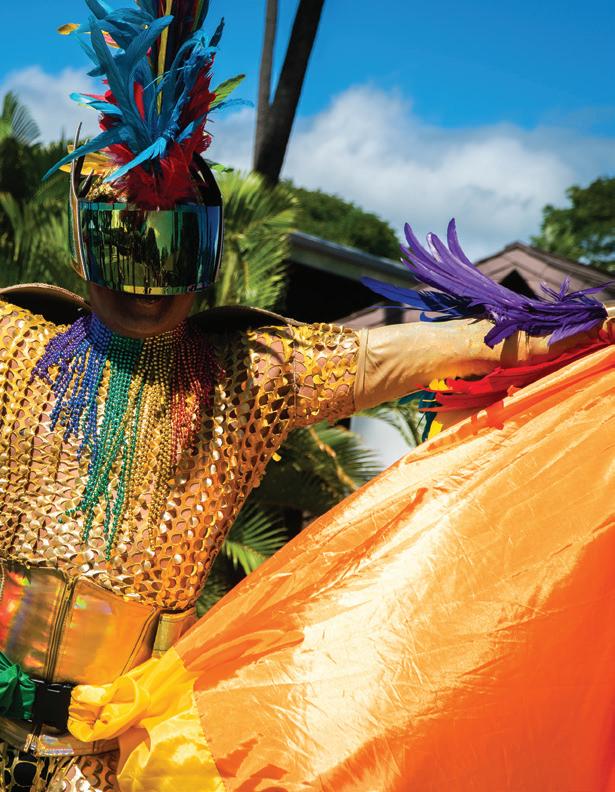
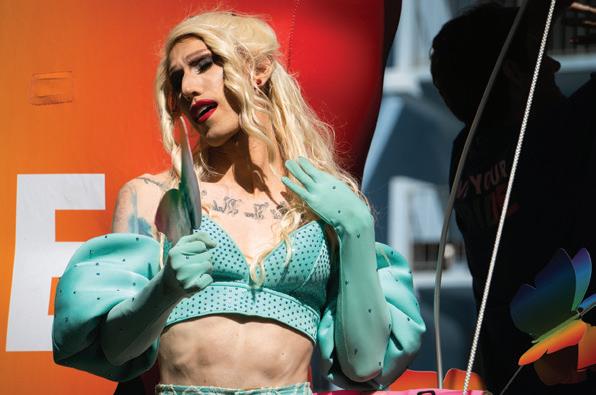
"
I remember we made eye contact. It’s like we were having a mini five second photo shoot together. It wasn’t planned. I thought it was really beautiful.”




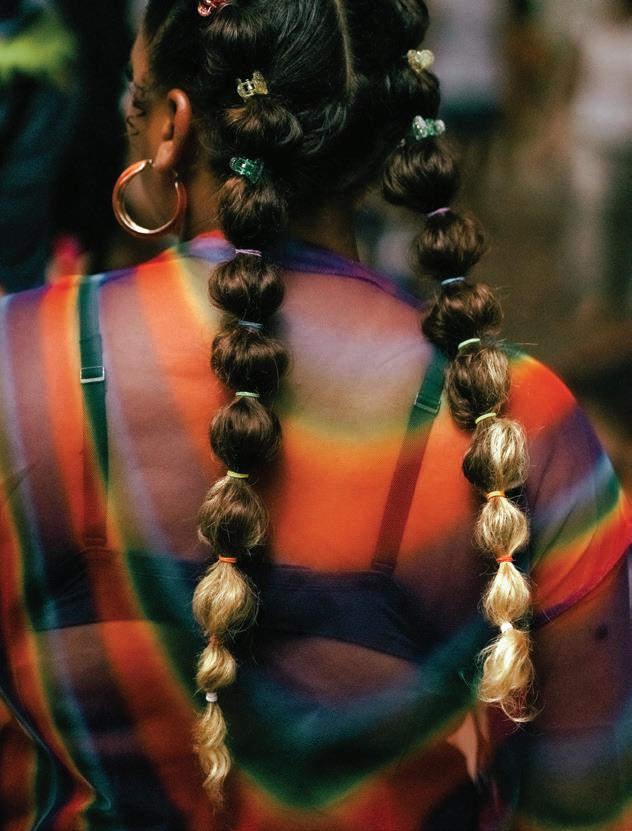

I feel like I followed her around for a minute before I took the photo because I wanted to get the perfect shot. She kind of felt like a superhero wearing a cape and riding a skateboard. She was just having the time of her life like everyone else in that photo.”
"


How the luxury florist behind Gentle Beast found family while showcasing the elegance and artistry of Japanese farmers.
When Kaiwen Nainoa Wang Nobriga first had the idea of starting Gentle Beast, his O‘ahu-based luxury floral company that now counts Cartier and the Obamas as clients, he ran into a tiny problem: he had no formal training as a florist.
For Kaiwen, flowers represent his childhood, his culture and his travel experiences. “No matter where I lived, I couldn’t resist buying flowers and nurturing plants,” he says. “Living in different regions with distinct four seasons brought me immense joy as I witnessed the various blooms throughout the year.”
However, upon moving to Hawai‘i, Kaiwen found himself missing this seasonal beauty and wanted to find a way to share that splendor with others. That’s when the idea for Gentle Beast bloomed.
Naturally, he turned to YouTube, where the algorithm kept feeding him videos from a woman in Osaka named Sachi Matsuura. He recalls quickly skipping past her flower arranging tutorials, which she posted under the handle HappyComeFlower, and thinking she’s kind of lousy. “Lousy in terms of so loud,” he says, laughing, “and super, super, super bubbly.”
But the algorithm persisted, badgering Kaiwen into finally finishing one of her videos. To his surprise, he discovered that he not only loved Sachi’s style with flowers but also appreciated her philosophy as a business person and a human being.
After taking a few of her online classes he went out on a whim and invited her to Hawai’i to collaborate on an event he was producing for the Hawai‘i Food and Wine Festival, in January 2023.
EXQUISITE BLOOMS WORDS BY MITCHELL KUGA IMAGES COURTESY OF KAIWEN NAINOA WANG NOBRIGA
36
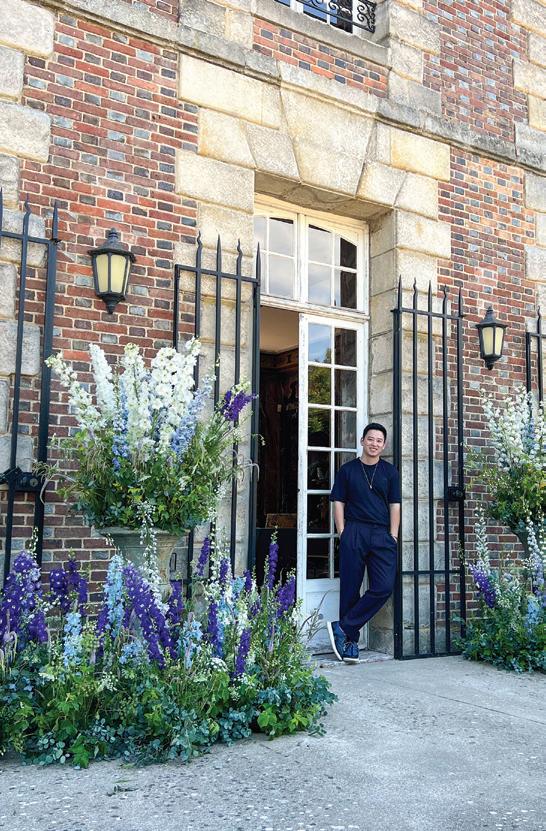


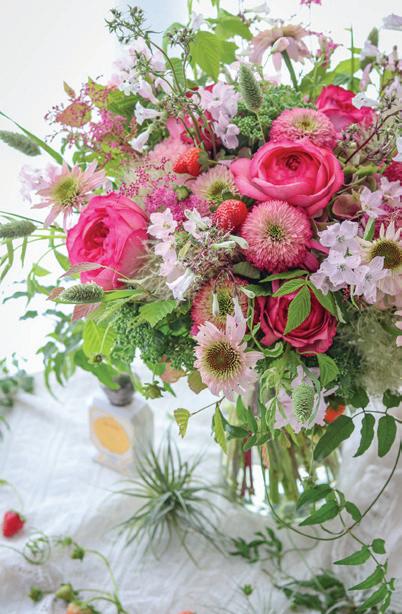
“I don’t know what she was thinking— she never met me in person before—but she flew over to Hawai’i and we met for the first time,” Kaiwen says.
The two hit it off immediately, and less than year later, she’s become more than just his mentor. “Now she’s like my mom,” he says.
From its focus on Asian hospitality to its European-style arrangements, Sachi’s imprint can be found all over Gentle Beast, which Kaiwen launched from his home in 2020 and now boasts a 1,600 square foot storefront at Ward Centre.
The shop specializes in made-to-order bouquets that highlight seasonal flowers sourced primarily from Japan and Europe, which are arranged around the “feelings you would like to express to the recipient,” Kaiwen says.
When ordering there are no samples; everything is done omakase. He cites omotenashi, or the philosophy at the center of Japanese hospitality, as a prevailing influence, particularly when it comes to the lifespan of his arrangements.
The Gentle Beast aesthetic is a lush, ever evolving garden, with Kaiwen hiding younger blooms within his arrangements to give them space to blossom over time.
“When I started the business I told everybody, we are not a flower shop, selling flowers per stem,” he says. “We are florists who are selling experiences.”
Travel sits at the heart of Gentle Beast. When I visited in July, the shop featured peonies from France, flamingo-pink roses from Japan, and powder blue hydrangeas from the Netherlands. Shipments arrive from all over the world three times per week, with packages from Japan being particularly exciting.
“It’s like opening a Christmas box, you have no idea what you are getting,” Kaiwen says.
He makes monthly trips to Japan to take private lessons from Sachi, and had recently returned from a tour of his vendors there, which he organized for Gentle Beast staff and a few customers.
Sachi joined, and the small group visited five flower farms, mostly small, family-run businesses located in the remote Japanese countryside, including Aichi, Shizuoka, and Kyushu.
“Despite being some of the most beautiful flowers in the world, the farmers have limited access to introduce them to a broader audience,” Kaiwen says.
Because the farms are typically not on Google Maps, detours ensued: the group got lost in the middle of a rice field at one point, and Sachi later drove them into a river.
But despite the missteps, Kaiwen maintains that those experiences as a traveler are what animates his approach to Gentle Beast.
“There are so many more opportunities and possibilities if you can expand your vision towards the world,” he says, adding that it was important for him and his staff to meet the farmers and see the effort they invest into their flowers. “I want to make sure they know what kind of product they are dealing with everyday, because the Japanese product is at least four to five times more expensive than the ones we get from Europe,” he says. “I want them to know the value behind it.”
“My hope is that by bringing these breathtaking blooms to Hawai‘i, I can play a part in introducing them to more florists across the United States. It would be a privilege to share the artistry and dedication of these Japanese farmers with a wider audience and give their creations the recognition they truly deserve.”
Kaiwen, 30, grew up in Shanghai and lived in Tokyo for five years, where he earned a
40

master’s degree in philosophy from Waseda University. He moved to Hawai’i in 2019 to be with his boyfriend and soon-to-be husband Lance, who grew up on Kauai and delivers flowers for Gentle Beast on his days off from handling explosion detection canines at the airport. (The two met on Grindr in 2018, while Kaiwen was visiting Hawai’i).
The name Gentle Beast is derived from a beloved poem by Seigfred Sasson, “In Me the Tiger Sniffs the Rose.”
“This poem has always held a special place in my heart, as it embodies the idea that even the wildest of souls can appreciate tenderness and beauty,” Kaiwen says. “It serves as a constant reminder of the delicate balance between strength and gentleness.”
The name also pays tribute to Kaiwen’s retired working dog, King, who served diligently as an explosive detection K9 for Homeland Security. “When I embarked on the journey of starting this business, King retired, and his presence continues to inspire our mission,” Kaiwen says.
Gentle Beast’s logo, featuring a blooming camellia seen through a traditional round Chinese wall window, is inspired by the family farm on which Kaiwen grew up.
Though Kaiwen found the transition to Hawai’i difficult at first, particularly during Covid, “it was one of the best decisions I made in my life,” he says, noting that he was abandoned by his parents when he was 16, after they discovered he was gay. “I have a family now.”
Sachi in particular has come to feel like a home away from home, which is why the two go out of their way to see each other each month. He’s even come to see reflections of himself in the parts of her that used to annoy him.
“She is still a little annoying— just loud,” he says. “But I can see myself. That’s why my husband says, ‘But baby, you are loud too.’” Their similarities have earned Kaiwen a new nickname around the shop: Sachi Jr. “But I’m just more sassy,” he adds.
More than as a florist, “I really, really love her and appreciate her as a person [first],” he says. “She treats me like her son.”
He’s also found family through the connections he’s created with customers at Gentle Beast. “I think running a business in Hawai’i is very different from any other part of the world, because people here come with a generous heart and great intentions and they care about you,” he says. “It’s a very small community, so you cannot just be a businessman here—you have to be a businessman with a very big heart.”
42

SHADES OF BLUE AND SOMETHING NEW ABERCROMBIE & FITCH | APPLE | BLOOMINGDALE’S | GAP | PSYCHO BUNNY | VICTORIA’S SECRET SHOPPING & DINING AT THE HEART OF THE PACIFIC ALAMOANACENTER.COM
As an architect fascinated by the world of fragrances, Carlos Huber is a master at capturing the essence of a place by embracing authentic historical experiences.
In the world of fragrance, scents often transcend their aromatic notes to evoke the presence of a loved one, transport us to a cherished place, or even encapsulate a fondly remembered moment in time. But what if these ethereal elements of time, space, and architecture could be woven together to create an olfactory tapestry like never before?
This is precisely the innovative approach embraced by Carlos Huber, the creative mastermind behind Arquiste Parfumeur. He’s not merely redefining perfume; he’s reframing it as a temporal and spatial journey.
“I see myself as a fragrance developer, an architect of scents,” Huber says. “I’m not a perfumer in the traditional sense; instead, I design the concept and the scent, then rely on expert perfumers to bring that vision to life. This mirrors the process in architecture, where the architect designs a space, and the builder executes it.”
The fragrances he crafts strive to capture the essence of specific moments and places.
Carlos has developed scents inspired by Sydney’s unique rock pools, with a mineral, ambery musk evoking a perfect day at the beach. For another, notes of Myrtle leaf, Calabrese
WORDS BY NICCOLO SERRATT IMAGES COURTESY OF CARLOS HUBER
44 SCENTS OF PLACE

citron, Sicilian lemon, Italian mandarin, bergamot, Mediterranean lavender, labdanum and cedar wood conjure an Italian citrus field in Medieval Calabria.
But one of his most notable creations is the signature scent for the prestigious St. Regis Hotels & Resorts brand, owned by Marriott.
This bespoke fragrance, the brand’s first, was inspired by the iconic hotel chain’s rich history and luxurious ambience, and named after Caroline Astor, the matriarch of the hotel’s founding family, and the 400 notable guests that represented the highest echelons of New York society. Its scent captures the exotic woods; the potted palms and apple blossoms that lined the hallways; the light crisp essence of champagne wafting through the crowds; and notes of rich American Beauty roses—her favorite flower—white lilies and the delicate sweetness of quince, apple and cherry blossom that filled the hotel’s ballroom.
“Our aim was to design a fragrance that not only transports people back to the early 1900s but could also work consistently across all St. Regis hotels worldwide,” Huber said while on a visit to The St. Regis Kanai Resort, in Mexico’s Riviera Maya, to promote his partnership with the brand.
Tell us about your journey from being an architect to becoming the founder of Arquiste Parfumeur?
carlos My journey began under the guidance of Rodrigo Flores, a prominent figure in the fragrance industry. As an architect fascinated by the world of fragrances, I noticed an intriguing intersection between architecture and perfumery. This realization happened during my year-and-a-half-long apprenticeship, during which I had the chance to dive deep into the fragrance industry.
I saw an opportunity to bring these elements into the perfume industry. I sought to capture and immortalize historical moments and experiences through perfume, much like architecture preserves history.
46
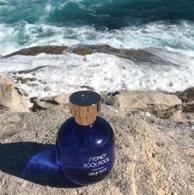


My vision was to recreate past experiences, not merely replicate old formulas, and transport people back in time through their senses.
My mentors, such as Rodrigo Flores, Yan, and Sofi, endorsed this innovative approach and kindled their passion. They supported my foray into the business side of the fragrance industry, using my connections with celebrated perfumers who have worked with big names like Ralph Lauren and Jo Malone. Their encouragement and passion fueled me to transform this idea into a unique brand that blends architecture’s methodology and storytelling with the art of perfume creation.
When you create a scent inspired by a specific place, what factors do you consider to capture the essence of that location? How do you translate the unique characteristics of a place into a fragrance?
carlos We consider various factors, such as the local flora, landscape, and architectural materials, to capture a snapshot of a place and its ambience. This approach applies whether we’re creating a beach scent, factoring in the smell of salt, sun cream, and human skin, or using architectural and botanical landscapes to derive objective location-related references.
Could you tell us what factors inspired you to create the signature scent of St. Regis?
carlos For this scent, I came across original New York Times articles from 1901-1904 mentioning the floral arrangements in the Astors’ mansion (the founding family of St. Regis) during their lavish balls. We researched specific floral arrangements used in the house, which each St. Regis hotel is
based upon, and attempted to recreate the scent experience of entering that house.
We always ask ourselves, “What are the unique elements in this scene?” and try to encapsulate them in the fragrance. So, when you walk into a St. Regis, you experience the same scent someone would have encountered at one of the Astors’ gala events—a snapshot of a place in time.
Can you share a memorable experience where you witnessed the powerful impact of scent in transporting people to a different time or place?
carlos I witness this impact quite frequently in my line of work. A personal example would be my first visit to Europe when I stayed at the Marriott in Grosvenor Square. The unique floral scent of the hotel lobby transported me to a different world. I was just 12 years old then and didn’t even realize that the captivating scent was due to the flowers.
As I matured, I understood how scent plays a crucial role in our emotional responses and interactions. It’s not merely about how a room smells; it significantly influences who we feel drawn to in romantic and platonic contexts. It can guide us towards those we feel compatible with and help us find our tribe.
Are there any upcoming projects or collaborations you are excited about?
carlos One project I’m very excited about is our collaboration with high-end tequila manufacturer Casa Azul. We’re launching a home scent in September, inspired by the highlands of the Jalisco region where the iconic brand produces its tequila.
48
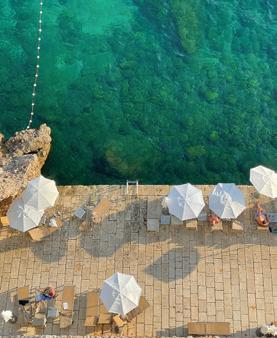

Finally, are there any places in New York or further afield that have lately inspired you?
carlos The Cloisters Museum, managed by the Met, certainly stands out. This museum, housing a medieval collection within recreated fragments of European buildings, has an unmatched energy that transports you to a different era and place.
I draw inspiration from the city’s vibrant restaurant scene, the riverfront reminding me of New York’s location between water bodies, and classic New York steakhouses with their distinctive wooden and leather aromas.
However, other cities like Seville, Sydney, and Mexico City intrigue me more when it comes to scents. For example, Mexico City’s scent of freshly made tortillas offers a unique and delightful olfactory experience.
50
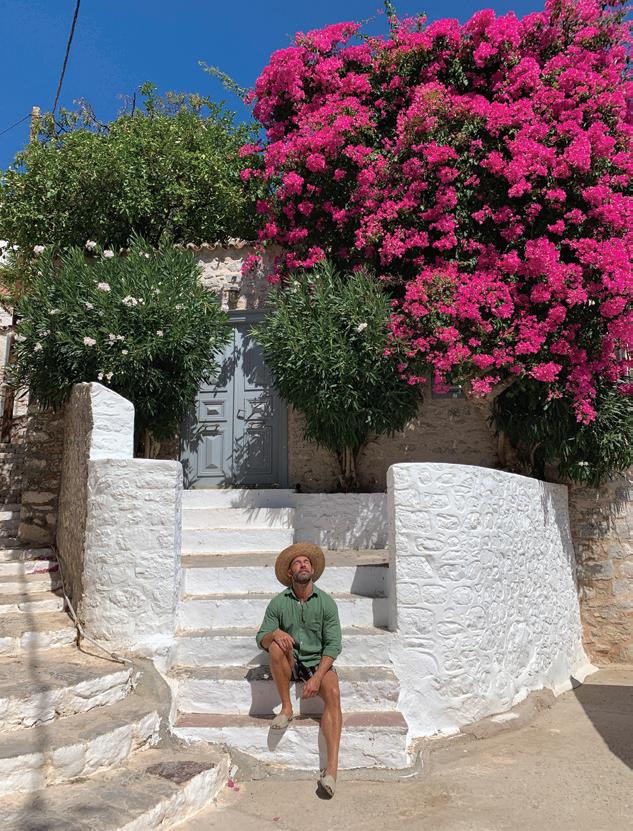

WORDS BY EDDIE KIM IMAGES COURTESY OF EQUATOR COFFEES 52 COFFEE CONNECTION
How two queer women found each other and chose to navigate a rapidly changing industry, hoping that doing things a different way could provide them with purpose.
For the last three decades, Brooke McDonnell and Helen Russell have raised and nurtured Equator Coffees into a Bay Area craft coffee powerhouse, earning rave reviews and industry plaudits for their range of delicious, nuanced beans.
The origin story reads like a small-business fairy tale: Two women start experimenting with handroasted beans out of a garage in the sleepy enclave of Corte Madera, California, and discover the perfect alchemy to bloom amid a 1990s coffee renaissance. But their partnership wouldn’t have happened if not for a fortuitous meeting some 500 miles away, at the queer gathering known as the Dinah Shore Weekend in Palm Springs.
It’s where Russell, a Boston native, first met Bay Area native McDonnell in the spring of 1989—and just a few months later, Russell decided she needed to move her life to San Francisco, too.
“Brooke took me to Cafe Flore and Caffe Trieste, and there was a place near my in-law apartment in Mill Valley—it was called the Roastery. I mean, growing up in Boston and just drinking Dunkin’ Donuts coffee all the time, then moving across the country and seeing craft coffee, a roasting machine and green coffee beans… I was just blown away,” Russell says.
Over the next few years, the duo traveled along the West Coast, wondering how their careers could unfold. Russell was a blue-collar Northeastern University grad with a nose for business; McDonnell grew up in a white-collar family and went to Skidmore for art. They dabbled in real-estate investing around the Pacific Northwest, sharing daydreams of entrepreneurship. Then, while sipping on Starbucks from a little kiosk in Seattle’s Pioneer Square, a lightbulb went off.



Russell loves to tell the anecdote: There they were, with Russell clutching a sweet mocha topped with whipped cream and McDonnell sipping on an espresso. “I said, ‘Brooke, you love coffee. I love business. We should really do something in this industry.’”
By the early 1990s, America’s coffee culture had begun to evolve, giving prominence to “second-wave” coffee brands like Starbucks and Caribou that offered people their first foray into espresso and specialty drinks. Although the notion of paying premium prices for a latte was still fairly radical among the masses, McDonnell and Russell invested in two coffee kiosks and opened their first business, dubbed Europa, in 1992 to serve downtown Oakland and downtown San Francisco.
“Starbucks hadn’t even come into town yet. This model hadn’t taken off. But it felt like a great time for a coffee entrepreneur to try something new. We had business people lining up at 6 a.m.,” McDonnell says.
Ever the connoisseur, Brooke began inquiring about the specific origin, growing environment and quality of the coffee beans she was purchasing wholesale.
“And our supplier replied by saying, you know, ‘Why are you asking all these questions? We buy from central, south, and east Africa and Indonesia.’ They didn’t understand why we wanted to know about the potassium levels in the social and the various microclimates in a region and if the children of these coffee farmers were going to school,” Russell says. “These questions weren’t really being asked, or answered, back then.”
It was the second lightbulb moment for the two women, who realized they could make a statement as an indie coffee roaster. By their count, there were only about thirty-something roasters working on the West Coast at the time. Nowadays, there
are over 300 in the region and thousands across the U.S., informed by decades of craft coffee knowledge and expertise. Not so much in 1995, when McDonnell and Russell took the funds from selling the Europa kiosks to a friend and opened Equator as a business in a garage, outfitted with just one tabletop Petroncini roaster and five-pound bags of green coffee from New York City-based Dallis Bros. Coffee. Their modest beginnings belied the swells of success that would come over the next 28 years. McDonnell honed her eye for roasting by taking advice from anyone who would humor her, and a seminal trip to Guatemala in 1997 proved that Equator needed to do more than sell good beans—it needed to tell a narrative about the people and places that grew them. The same year, the company became the first California roaster to earn Fair Trade certification, at a time when sustainability and ethical sourcing were fringe topics.
In 2003, rising demand led to Equator’s expansion into their current roasting facility in San Rafael, Calif. The wholesale operation grew steadily through the decade, buoyed not just by sales to cafes but also tech companies and chef-driven restaurants. In 2013, Equator launched its very first retail location in Mill Valley. Then, three years later, the Small Business Administration awarded Equator as the national small business of the year. It was the first LGBTQ-owned business to win the accolade.
It proved to be a moment of reflection for McDonnell and Russell. Their queer identities had taken a backseat when Equator first launched—at the time, it seemed challenging enough to be a woman-owned roastery in a male-dominated industry. Today, Russell feels a twinge of regret when describing feeling trapped, in part by her own fears but also societal norms at the time.
56

“In the beginning, I wasn’t talking about being gay or Brooke and I being life partners. We just talked about the product and how it could help you. It really wasn’t until we won as a LGBTQ small business on a national stage that we really started talking about how important that was,” Russell says. “Of course, we’re in the Bay Area and it’s a bubble, but it was clear how important it was for our team, a number of whom are queer. The people that work for us are so proud to be associated with this.”
In the last seven years, Equator has affirmed its identity as an LGBTQ-owned company that actively supports the community. It’s also evolved in scope, with its first expansion out of the Bay Area in 2022, via a glitzy new store in Culver City in Southern California. It was the speartip of a southbound push, with another opening this year in Los Angeles’ hip Fairfax district and a third location planned for the picturesque town of Laguna Beach.
Equator has certainly outgrown its ragtag roots — McDonnell jokes that the employees have no idea she used to be the company’s sole janitor. Despite its rise, Equator has maintained the principles of equity, transparency and inclusion that she and Russell discussed all those years ago. McDonnell boasts that any employee is welcome to pore over their financial records. And beyond fair wages or philanthropy, the duo have chosen to invest directly at the source, co-owning a coffee farm, Finca Sophia, in the highlands of Volcán, Panama. In so many ways, Equator Coffees is a project borne out of an intense journey of discovery. Russell and McDonnell may have grown older and wiser since, but the innate joy remains.
“You feel a sense of wonder in coffee that I think even the current younger generation getting into this industry can
feel,” McDonnell says. “The same way I felt in 1995, when I started roasting. You can connect with distant communities with just the smallest steps, whether it’s paying the right price or partnering with a farm. You can make a ripple effect by doing amazing work in coffee. And it made our world a little smaller, in the best way.”
58

Hotels are a microcosm of acceptance and equality. At least the best ones are when they choose to be.
I remember the first time I was asked if I needed a second bed or separate bedroom while checking into a hotel in Chicago. I was with my husband, and instantly made to feel wrong because I was questioned if I had made a mistake while booking my stay. Even though we were together, the associate wanted to fix the error, and as a result, our existence as a married couple.
The moment stood out to me then and still does now because hotels typically represent a microcosm of people who are welcomed—always, no matter where or who they are.
When successful, these are safe, stylish, even trend-setting spaces that make anyone feel seen, equal and valued without question or effort.
The LGBTQ traveler is more cautious than ever in choosing where to stay. We live in a world of increasing contradictions and instability, so we pay attention to what businesses do, and how they try to connect with their customer—or make an effort not to.
While browsing the Instagram feeds of ten high-profile hotels in Chicago, operating under the Marriott, Hilton, Hyatt, Intercontinental, Peninsula, Thompson, Peninsula, Waldorf Astoria, St. Regis and Ritz-Carlton banners, not a single one had a post that courted members of the LGBTQ community throughout June, Pride Month.
Dogs, while cute, got more exposure. There was a post about Taylor Swift, though. Sorry, not close enough.
It was a different story on the social media feeds for Chicago’s two W hotels, and ones from the city’s Virgin Hotel; The Gwen, a Luxury Collection Hotel; and The LaSalle, a handsome new member of Marriott’s Autograph Collection. There were multiple posts with people, not just rainbow flags. Effort was made.
WORDS BY MARC GRASER IMAGES BY
HARRY DAVIS
60 WHERE LGBTQ TRAVELERS ARE MEANT TO BE SEEN
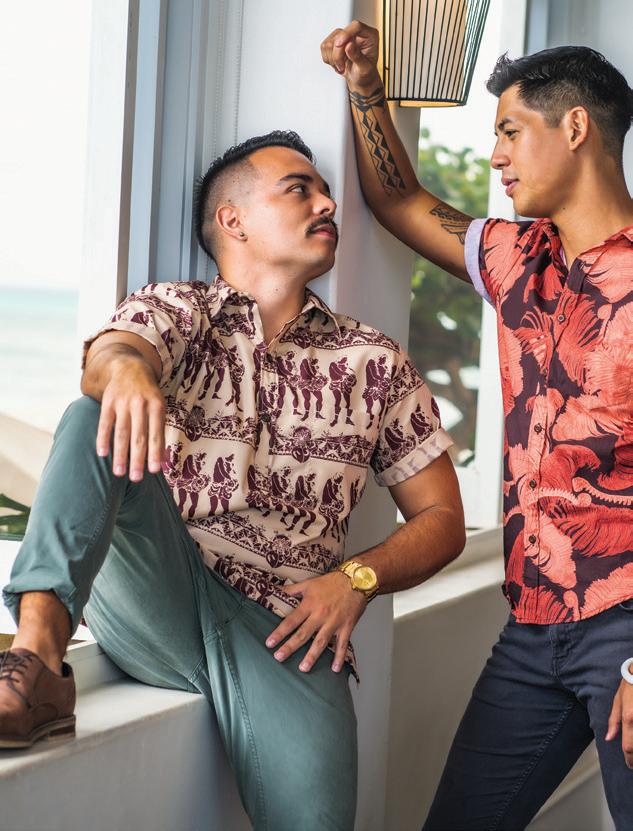
Representation matters, and the hotels that acknowledge their customers get rewarded for it.
In all of those cases, a decision was made to choose not to acknowledge an entire community of people who are celebrated during the same month each year.
And it’s a growing group of individuals with clout worth paying attention to and connecting with.
In fact, the LGBTQ community spends more than $200 billion on travel each year. We take vacations, we celebrate special occasions, we need to unwind, relax and seek out every opportunity to live well like anyone else. We’re here, we travel, get used to it.
I chose Chicago but I’m sure a social media search would have ended up with similar results on hotel channels in other cities.
I’m not saying every hotel brand needs to be Axel Hotels, an LGBTQ-first brand that playfully claims to be hetero friendly, or Palm Springs’ Hacienda at Warm Sands, an elevated desert retreat that caters primarily to gay men. But Pharrell Williams’ The Goodtime Hotel, in Miami, or the Kaimana Beach Hotel, in Waikīkī, regularly feature LGBTQ travelers enjoying themselves during their stays without overdoing the message-heavy hashtags.
Representation matters, and the hotels that acknowledge their customers get rewarded for it.
I see and want to spend my time in their cool bars, trendy restaurants, relaxing spas and upgrade to a suite. I appreciate their design choices, and make plans to experience what the brand is doing in other destinations. I see them because they see me and share my experiences with my friends, family and allies.
If there’s a reason I’ve gravitated to brands like Autograph, Virgin and W over the years, I only need to point to how they communicate with me.
In short, they want my business. They would never ask if I need a second bed or another room. They aspire to serve everyone, whenever, wherever, to borrow a little from W’s favorite phrasing. I’m not a gay traveler to them. I’m me in the most authentic and genuine way.
When everything clicks—amazing customer service, striking design, exceptional culinary offerings, first-rate amenities—a hotel becomes as close to an individual as you can become. It gains a personality, an attitude, a vibe people yearn to be around and spend more time with.
A hotel may advertise as being welcoming to LGBTQ travelers, but if the reviews, reputation and their marketing channels don’t reflect that, it won’t align with my expectations and preferences, once I’m a guest.
During Pride, the right hotel doesn’t shy away from saying love is love, no matter the gender.
The perfect hotel doesn’t need to be prompted to show it cares about the LGBTQ community year round. Create an inclusive environment. Don’t ignore people like me or members of my community. Make an effort. It doesn’t take much if you care. It all comes down to choice. Yours and, ultimately, mine.
62
"
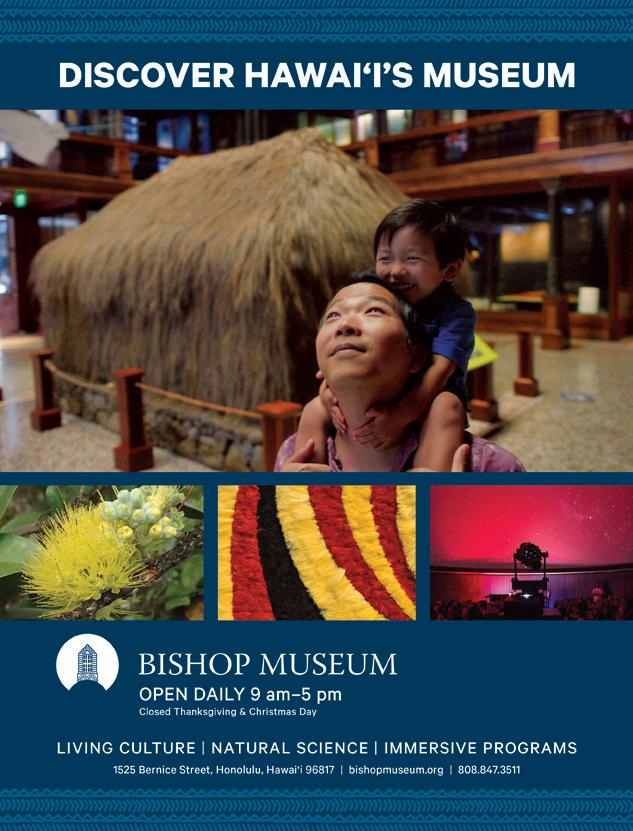
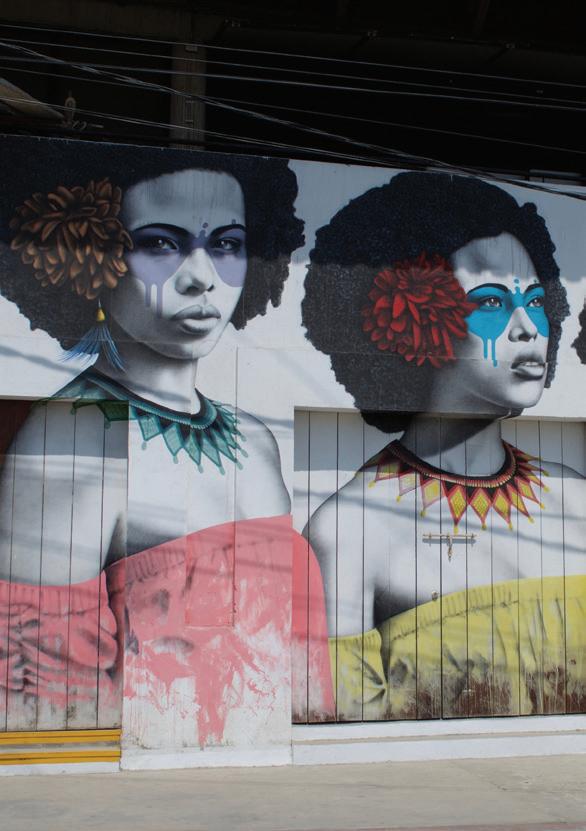
II. Culture
Exploring the creative arts, intellectual achievements and thought provoking beliefs of inspiring minds
In the realm of LGBTQI+ spaces, where representation still falls short, Adam Nathaniel Furman rises to reclaim the overlooked havens designed and cherished by queer individuals.
When “Queer Spaces: An Atlas of LGBTQ+ Places and Stories” was published in 2022, Adam Nathaniel Furman (they/them) had one goal in mind: for the tome to serve as a beacon, offering historical narratives of queer spaces, shield students from scathing critiques—an experience all too familiar to him—and to bring global attention to these sanctuaries.
In short, they wanted to put a spotlight on unsung pillars of our community that, regrettably, rarely receive the recognition they so deserve.
Through Adam’s invaluable work, the world’s eyes have been opened to the Trans Memorial and Archive in Buenos Aires and the Black Lesbian and Gay Centre in London.
There’s also one of the first gay bars in Tokyo’s Shinjuku Ni-chome; a crumbling cathedral in Managua that’s a sanctuary for the local queer community; an independent bookshop in Glasgow; and ice cream parlour in Havana, “where strawberry is the queerest choice.”
“The personal drive behind my focus on ‘Queer Spaces’ emerges from my own lived experiences,” says Furman, who is of Argentine and Japanese heritage based in London. “As a queer individual studying architecture, expressing my identity through work proved an arduous journey. Those brave enough to incorporate queerness into their architectural projects often faced ridicule and scorn, while many others either abandoned their visions or conformed to societal expectations.”
WORDS BY NICCOLO BRANDON SERRATT IMAGES COURTESY OF ADAM NATHANIEL FURMAN
66 DEFINING QUEER SPACES

Can you give us some background on your journey as an artist and designer?
Adam: I began my artistic journey in 2001 when I studied architecture at St. Martin University, completing a foundation course. After graduating, I ventured into the industry while pursuing my own creative practice until 2016, when I decided to venture out independently. I’ve been involved in various artistic endeavours, including publishing, journalism, art installations, and pavilions. Finding likeminded individuals in my generation was difficult, which compelled me to pave a different path.
What inspired you to focus your work on “Queer Spaces”?
Adam: What struck me was the absence of historical references and examples of queer spaces for students to draw upon when justifying their work. This void left them vulnerable to criticism from their tutors. In collaboration with fellow passionate individuals, I took it upon myself to coauthor a book backed by the esteemed Royal British Institute of Architecture. This book explores the captivating fluidity and ethereal nature of queer spaces, establishing a rich tapestry of references for students and creating a much-needed platform for discussion and understanding.
Could you describe queer spaces in three adjectives that define them?
Adam: “Heirloom” reflects that queer individuals are not automatically born into an established ethnic or cultural group and
often must find and form their own culture and community. These spaces help prevent the erasure of older queer individuals’ existence and recognize their valuable contributions to society. “Hope” represents the resilience and determination of the queer community. “Beauty” is a significant aspect of queer spaces, just like the beauty celebrated within queer individuals.
Can you share examples of architectural projects or spaces that have successfully promoted inclusivity and diversity?
Adam: I find inspiration in particular projects that foster a sense of community and acceptance. For instance, the Trans Memory Archive in Buenos Aires is an essential example of passing down knowledge and experiences. This community-driven archive was created by trans people who came together on social media, learning how to raise funds, catalogue, and preserve their history for future generations.
Closer to home is the Black Lesbian and Gay Centre in London exemplifies resilience in the face of adversity. The centre found its space in the railway arches, proving its determination to provide a haven and support for its community, even amidst hostile attitudes.
Could you discuss a specific project related to queer spaces that you’re working on or recently completed?
Adam: One of the projects I’m currently involved in is an exhibition at Kew Gardens scheduled for autumn. It explores the
68

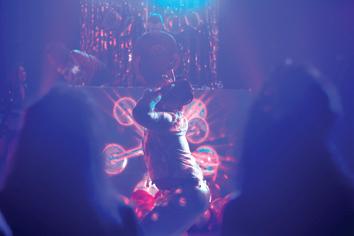
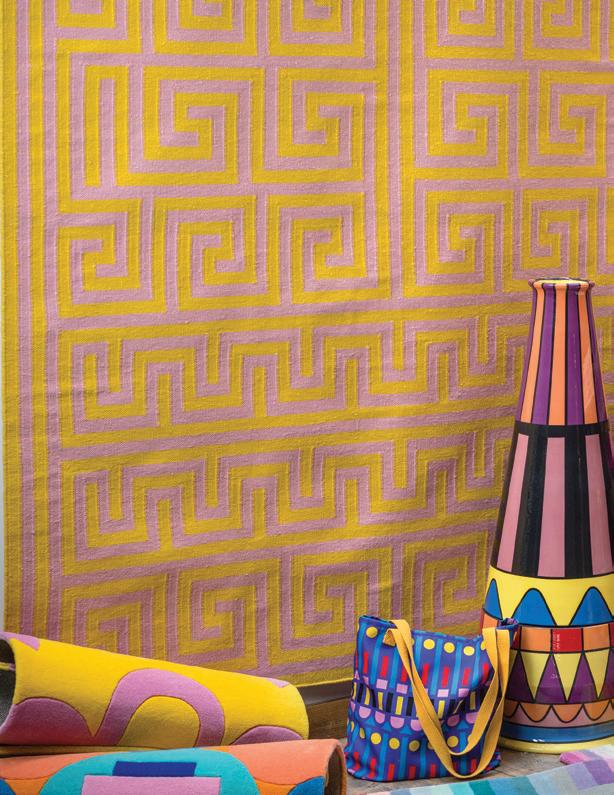
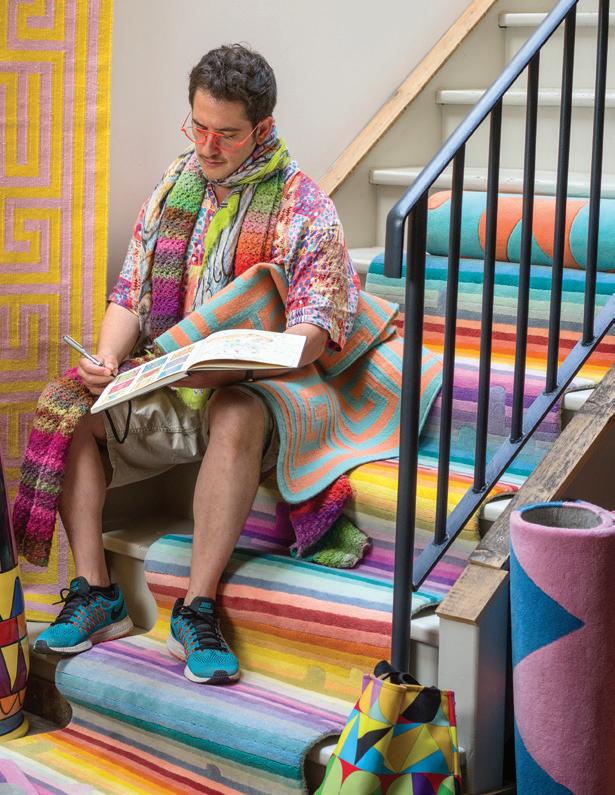
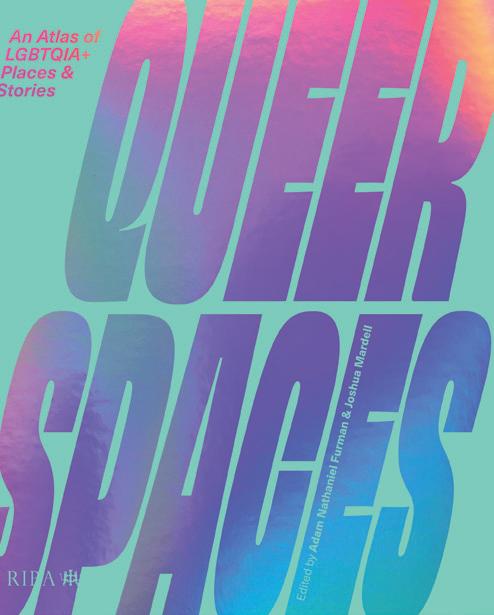
concept of “Queer Botanicas,” and delves into the fascinating queer aspects found in the biology of flowers. In addition, I’m about to launch a permanent art piece called “Kick Your Heels Three Times” on the Norman Foster Bridge connecting One Canada Square to the Elizabeth line train station in Canary Wharf. This artwork features a barcode of colours that represents the diverse and inclusive reality of the queer community.
Are there any misconceptions or misunderstandings you often encounter when discussing the concept of queer spaces, and how do you address them?
Adam: One common misconception is that people often equate queer spaces with a particular style. Some ask if a “queer building” has specific aesthetic features. While it may seem amusing initially, it can sometimes be frustrating. Queer aesthetics are not limited to a single style but encompass many aspects. Queer spaces arise from the creativity and resourcefulness of queer individuals in specific times and places rather than conforming to predefined formal tendencies.
The assumption that queer spaces are solely related to sexual activities or are sexually explicit annoys me. This is an outdated and harmful stereotype. Queer spaces represent inclusive and welcoming environments where all aspects of queer identity are celebrated.
How do you envision your works on queer spaces contributing to the broader conversation around LGBTQ+ rights and representation in society?
Adam: My works on queer spaces aim to empower queer architects, creatives, and individuals by offering historical references and representations. My book, “Queer Spaces,” has been successful, reaching a broader audience. It presents queer spaces in a relatable and accessible manner, challenging misconceptions and promoting understanding. I believe that creating visibility for queer spaces will foster more appreciation for the resilience and creativity of the queer community, countering negative portrayals often seen in the media.
Are any specific places significant to the queer community you love?
Adam: The intention behind my book is to demonstrate that queer history exists everywhere. However, I have a personal affinity for the queer history and community in Central and South America. Sadly, Western writers often overlooked the histories of these vibrant and colourful communities. These regions boast rich queer cultures, especially in cities like Buenos Aires and Mexico City, where artists thrived, thanks to their size and a developed middle class that allowed for the flourishing of queer expression.
San Diego’s crankiest drag queen spills party stories from Aspen Gay Ski Week.
My parents weren’t the least bit surprised when I decided to become a drag queen. They couldn’t keep me out of my grandma’s closet growing up—there are pictures of me in knee-highs and pantyhose and ladies’ hats because I’ve been cross dressing since I was four.
I started dabbling in drag during college. The closest drag club from me at school in northwestern Arkansas was in Tennessee, so anytime I would go visit home in northeastern Arkansas, I would take the family minivan and drive an hour and a half to Memphis for amateur night. Eventually I decided I wanted to make a career of it, and I’ve been a full-time drag performer for a few years now.
Mariam T is kind of like Benjamin Button. Originally she was this older Yiddish woman who spent way too much time at the casino, but as I’ve explored her personality and grown with her, she’s gotten younger. Now Mariam is an early-forties sex bomb but matronly, like a well-kept stepmother. She’s married to somebody with lots of money who she doesn’t have to talk to very often.
Mariam’s favorite colors are floral and leopard, so there’s always an element of tackiness, but she’s so glamorous that you don’t care that the dress she’s wearing is made of the same fabric that’s on the chair in the hospital waiting room—yes, it’s ugly, but fabulous somehow.
I’m known as San Diego’s crankiest drag queen. I like to say that I’m the Gilbert Gottfried of drag; there’s a lot of screaming and yelling involved. Mariam is very curmudgeon-y, but she’s always a good time. You’re going to get made fun of, and you’re going to laugh a lot.
AS TOLD TO LAUREN MCNALLY
IMAGES BY ERICA JOAN
74 CRACKING JOKES
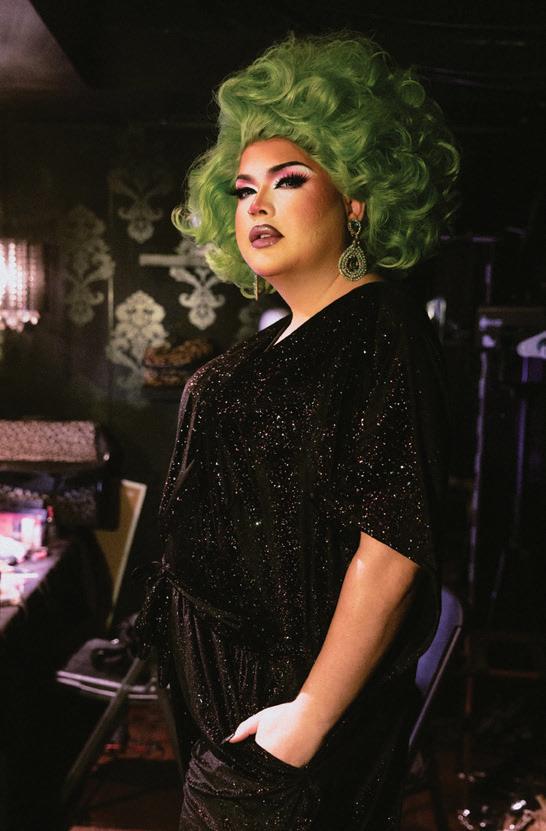
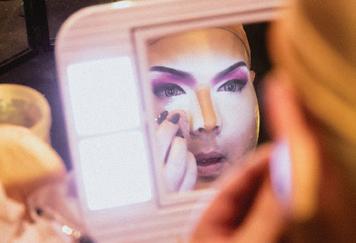

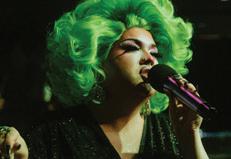
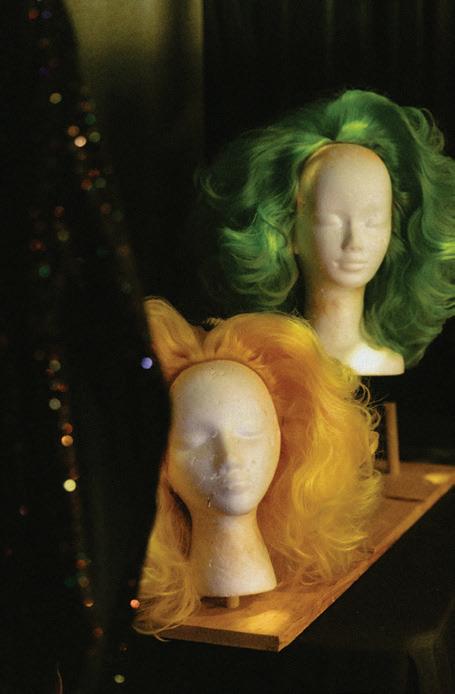
I’m a trained standup comic—that’s what I did before drag—and I don’t think people are expecting all the jokes and sharp wit. My bingo shows are like a musical performance and bingo game and standup comedy night all in one.
The former marketing director of the restaurant group I do drag for in San Diego now does marketing for Aspen Gay Ski Week, so when the organization was looking for someone to host drag bingo, they asked if he knew anyone and he was like, Oh, I know the bingo queen.
They shipped me out to Aspen for the first time in 2020. I had a long layover and was drinking bubbles the whole way there, so I fell asleep on the flight. After we landed, the flight attendants had to wake me and tell me to get off the plane. I got out and was like, Where am I? I’d never been there before, and it felt like I’d been dropped in the middle of a Hallmark Christmas card.
The more time I spend in Aspen, the more I realize it’s not all high-end luxury boutiques. There are quirky little shops and much more character than I was expecting. And I assumed it was going to be all prim and proper, but people in Aspen are really fun to party with. If anybody ever wants to find me in Aspen when I’m not doing a show, I’m usually at Clark’s Oyster Bar in my caftan drinking with all the locals.
I get treated like a baby celebrity when I’m in Aspen because I stick out like a sore thumb. I’m more accessible than a real celebrity, though, because I’ll come out and talk to you after the show. We can hang out, do tequila shots, take pictures, send videos to your grandpa or your kids.
There aren’t a lot of drag queens in Aspen, so I think people aren’t used to that kind of entertainment. They’re happy to have it at all, which makes my job really easy. Everyone is so intrigued by the whole
concept of drag, it’s like moths to a flame. Every Gay Ski Week event we’ve done has sold out.
My favorite moment of Gay Ski Week last year was hosting the Downhill Costume Contest. That’s when we bring the giant LGBTQ flag down the mountain, and the energy is through the roof. As the host, I basically get pelted with snow for three hours. I gave up trying to hang on to my Champagne flute, so I was drinking bubbles right from the bottle like a real class act, berating the crowd and getting people to take their clothes off in the snow for $500 donations.
After that, we raged. I passed out at 6 p.m. and accidentally slept through the pool party. I woke up at two o’clock in the morning in a full face of makeup. But we raised a ton of money and had a lot of fun.
It’s very energy consuming, but I get a lot out of being Mariam. I’m a fairly highstrung person in my everyday life, but I’ve found that I’m able to exhaust a lot of that on stage. I think I’m more comfortable with who I am and more chill the rest of the time because of her.
Mariam has also made me realize the importance of humor and making people laugh. People are always coming up to me after shows to tell me things like, This is the first time I’ve laughed since my dad died.
There’s a part of every show when I bring audience members up on stage, anybody who’s celebrating anything: birthdays, divorces, beating cancer, coming out, pregnancies, bachelorette parties. Once, we celebrated the reunion of two sisters in their seventies who hadn’t spoken in 40 years.
Moments like that never get old. They’re one of my favorite things about what I do, second only to hearing people constantly tell me I’m gorgeous. That never gets old, either.
78

CASS Winery is proving as extroverted as it’s elegant with experiences that have become a beacon of queer joy in the heart of a conservative town.
When Andy Macdonald joined CASS Winery in April 2022 to oversee their private events, he could’ve never imagined some of the things he would experience—including performing in drag for a crowd of more than 250.
CASS Winery sits on 145 acres in the prime wine territory of Paso Robles, California, accessed by a winding two-lane road that cuts through rolling golden hills. It opened in 2005 with just a handful of vintage wines, and has since grown into one of Paso Robles’ most unique destinations, touting nearly a dozen wine varietals and a diverse range of activities beyond the usual tastings.
That includes events like the drag brunch, held in May to coincide with the popular Paso Wine Fest. Thanks to his acumen at throwing events, Macdonald had made connections to stars from one of his favorite shows, “RuPaul’s Drag Race.” So he courted five queens from across the U.S., including Shuga Cain and Derrick Barry, to glam up CASS in a dance party under the summer sun.
He knew those RuPaul stars would slay in front of the crowd, but wasn’t so sure about his own talents. “I’ve been intrigued by drag for a long time, but I’m a bearded man,” Macdonald says. “I haven’t shaved that beard in over a decade. But I thought, you know what, let me talk to the queens and see if they’ll make me over for this show.”
SIP AND STAY WORDS BY EDDIE KIM IMAGES COURTESY OF CASS WINERY
80
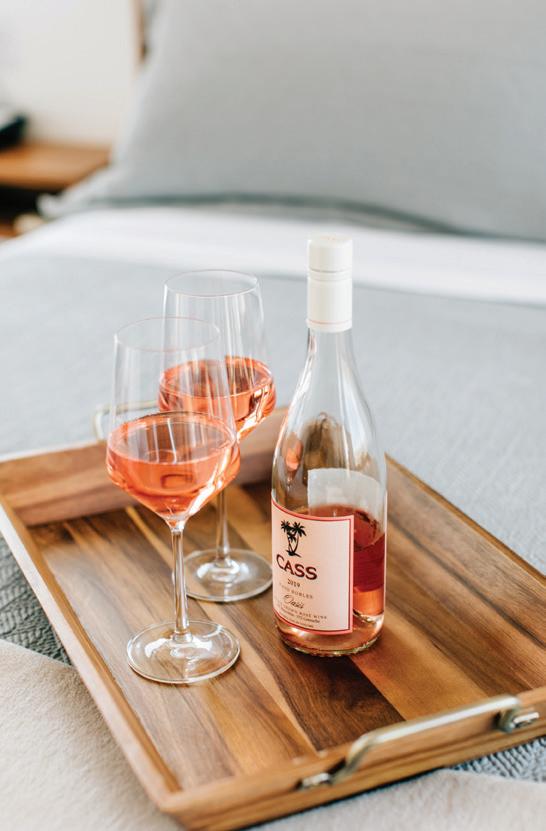
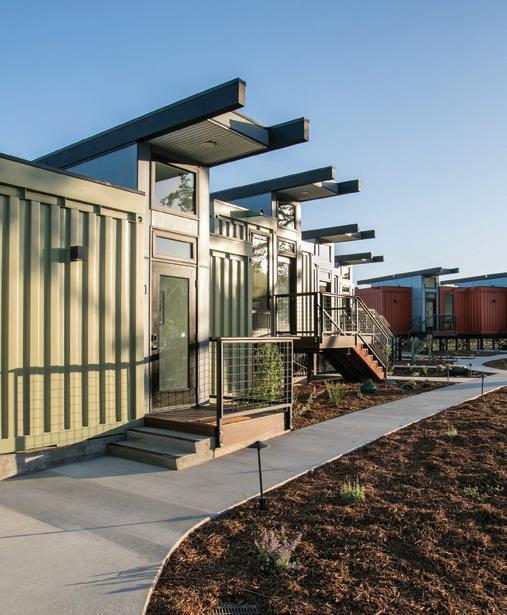
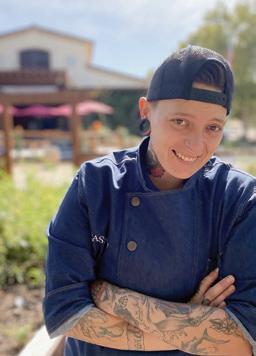

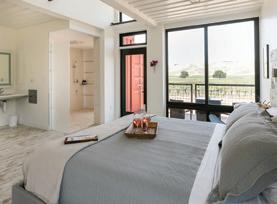
And just like that, Macdonald emerged as a ravishing blonde with a fitting name: Miss Honey Buttah. Filled with butterflies but looking glam in a black corseted dress, Honey Buttah took the stage at the brunch, dancing and singing to “This Is Me,” from the musical “The Greatest Showman.” Macdonald couldn’t help but notice the cheers and cathartic tears in the crowd.
“I think it said something that six other winery owners attended the drag brunch,” Macdonald says. “And for them to reach out and say that they love what we’re doing with the community at CASS, and want to help and be a part of future events like this. Knowing other people and winery owners in the community are buying into the idea of creating spaces and events for everyone… it was the most heartfelt thing to me.”
Beyond just a winery, CASS has long had a penchant for hosting unique events that draw a crowd. It’s a natural result of co-owner Steve Cass purchasing land in eastern Paso Robles, separated from the critical mass of wineries at the turn of the millennium.
“When we opened, there were only seven or eight wineries around us,” Cass says. “People needed actual maps to find us so we thought we should focus on events to attract people to the area.”
Cass left a two-decade career at the brokerage Charles Schwab in San Francisco and, at the age of 48, wondered how he should pivot. He flirted with a few different ambitions, including a sketchy plan to sail
around the world and a brief dalliance with classic cars. More than anything, Cass knew he wanted to move out of the city.
There, while driving past wineries and seeing grapevines lining the Paso Robles countryside, Cass hatched a plan. He didn’t know much about growing grapes, but he could acquire some land, start a vineyard, and pay an expert to tend to the vines.
Cass bought 145 acres in the summer of 1999 and oversaw the planting of 12 varietals of grapes the following year. What he didn’t realize was how bored he would get while waiting for the vines to mature.
While drinking delicious, full-bodied wines for a killer price at Fairview, the winery owned by legendary South African winemaker Charles Back, Cass and Ted Plemons, who had built the farmhouse on the vineyard (as well as Cass’ personal home), paired up to operate a full winery, not just a vineyard in Paso Robles.
The first harvest came in 2003, and CASS Winery debuted in 2005, offering a few vintages in French Rhone varietals such as Syrah, Viognier and Roussanne, as well as a Cabernet Sauvignon. The future remained uncertain: “It takes quite a while for a winery to turn a profit,” Cass notes. Just opening and tasting the first vintage felt like a victory nonetheless.
Over the next decade, CASS continued to grow, earning critical praise for their wines and earning a reputation as a destination in east Paso Robles.
84

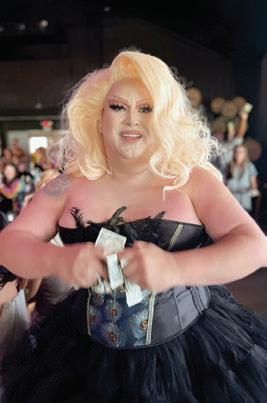

A major development arrived in spring of 2020, with the completion of the Geneseo Inn, a luxurious eight-room hotel built from interlocking shipping containers. Initially designed to attract overnight stays after events like weddings and tastings, the inn became a crucial asset amid the onset of COVID pandemic, with guests able to eat, drink and recreate in acres of open space.
In the last two years, the winery has brought on fresh talent to evolve the food and hospitality at CASS. For Taryn Bauer, coming onboard as the head chef of the tasting room cafe has been the highlight of her career. She and her team of five cooks make everything from scratch, from salad dressing to pizza dough.
Cooking at a winery can be chaos, Bauer says with a laugh (“Like when three tour buses pull up and drop 80 people into the dining room.”) But while she enjoys the thrill of performing under pressure, the 33-yearold chef notes that the biggest reward is feeling empowered by Cass to be creative and lead her team with full agency.
“I’ve heard from so many people that coming to CASS is like becoming part of a family. That’s a cliche but in this industry, when it’s busy, you can always see the stress on an employee’s face,” Bauer says. “So it’s special to come to CASS and see people who care about each other, having a good time, sharing laughs. Even in the middle of a rush, I’m still dancing.”
It’s a similar sentiment from Macdonald, who also leads the Camp CASS program, billed as an “adult summer camp” with archery, scavenger hunts and lessons on beekeeping, and wine making, of course.
“It’s just a very unpretentious way to go about running a winery, truly,” Macdonald says. “It’s fun, it’s comfortable, it’s for everyone. Like it says on our shirts, it’s French DNA and Paso personality. That personality is dynamic—it’s eccentric and extroverted as much as it’s elegant. And I love being able to do it all.”
Horticulturist-turned-fashion designer David Shepard’s biggest muse remains the natural beauty of the islands.
On the final night of the Merrie Monarch Festival, the decades-old hula competition that transforms Hawai‘i Island’s typically quaint Hilo town into a week-long epicenter of Hawaiian arts and culture, dancers from Hālau Kiawekūpono O Ka Ua took the stage. Like many other hālau hula (hula schools), they were clothed in aloha wear. It’s the style of dress that is the preferred mode du jour of the islands if the colorful outfits adorning the crowd of performers and spectators were anything to go by.
As the hālau danced across the hallowed stage of the Edith Kanaka‘ole Stadium, their movements were accentuated by their vibrant garments, particularly the vivid depictions of Hawaiian flora that decorated their crisp button-down shirts: swaths of prickly leaves in shades of aquamarine punctuated by the bold white blooms of the pua kala, the thorny poppy endemic to the islands’ windswept coastline.
Elsewhere in Hilo, David Shepard watched the performance live on a television screen, in awe at seeing his designs grace the festival stage for the first time. The feat of dressing a Merrie Monarch hālau is a milestone for any Hawai‘i designer. The festival draws in a global audience every year, considered a modern cornerstone of Hawaiian culture.
For Shepard, whose eponymous aloha wear line was a mere idea four years earlier, the event felt like an arrival—a reminder that his work now lived beyond the modest home studio and sketchbooks that first gave them life.
BOTANICALLY INSPIRED
WORDS BY EUNICA ESCALANTE IMAGES BY VINCENT
AND
88
BERCASIO
DRAEDON SAYABOC

“Watching them...it hit me full force. I just thought, ‘This is the dream.’” he says. “To have it represented there on the stage at Merrie Monarch was just unbelievable.”
Despite his meteoric rise in Hawai‘i’s fashion scene, a younger Shepard had no inklings of becoming a fashion designer. His was an upbringing lived amongst the rural pastures of South Florida, where the exotic flora of the tropics thrived. These plants were his first love. He explored his surroundings to studiously research unique varieties. From the age of 13, he nurtured a garden in his backyard lined with his favorite plants.
In 2013, he moved to Hawai‘i for graduate school, fascinated by its array of native species. While there, he was confronted with the bleaker side of horticulture, where rare plants teetered on the edge of extinction.
“It wasn’t until I got here that I was like, ‘Oh my gosh, this is next level,’” he says. “The way Hawai‘i cares about the environment and really walks the walk—the whole world needs to learn about it.”
Upon graduating, he landed a position with the National Park Service that placed him on assignment in Kalaupapa. For centuries, the isolated peninsula on the northern tip of Moloka‘i functioned as a Hansen’s Disease colony. Much of its environment remains relatively undisturbed.
Tasked with caring for the community’s nursery of Native Hawaiian plants, he spoke regularly with Kalaupapa’s residents, many former Hansen’s Disease patients. He learned of the stories behind each plant, how in Native Hawaiian culture each species from the smallest fern to the thorniest flower had a meaning.
Inspired, Shepard thought that “if you can get those stories into people’s hearts
and homes on a larger scale, then you have a real chance to save [the plants].” But it isn’t enough to get just anybody to pay attention.
To make a real difference, Shepard understood he had to get these stories in front of the “decision makers... the people that are writing policy.” Politicians, though, are inundated with information. How does one cut through the noise? He knew he alone couldn’t deliver the message. So, he enlisted the politicians themselves to spread the word for him.
He saw an untapped potential in aloha shirts. The colorful button-downs decorated in a medley of floral prints are best known from “Magnum P.I.” Today, aloha shirts are the islands’ unofficial uniform, serving the same function as the conventional business suit. If Shepard could weave the stories of Hawai‘i’s native plants into the wardrobes of the most influential, then he had a real chance of making them notice.
“My goal is to really create an impact in Hawai‘i for the conservation of these plants, which I’ve devoted my life to,” he says. “I see this as a way for me to bridge the gap, to get those plants in people’s living rooms and their hearts through storytelling.”
Equipped with a background in art, he experimented with patterns featuring Native Hawaiian flora. He cites ukiyo-e or Japanese woodblock prints as an early inspiration. One can see the comparisons in Shepard’s delicate yet dramatic linework or his penchant for bright color palettes.
His debut design was an ode to the Moloka‘i peninsula where his creative seeds were initially planted. “Inspired by the living tapestry of native Hawaiian plants hugging the coastal jet black lava rock,” he created a pattern of meandering pua kala poppies.
90

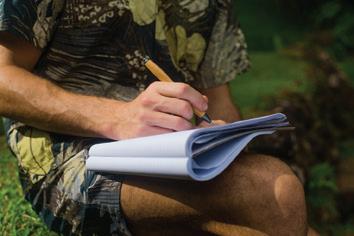
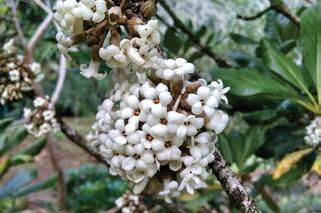
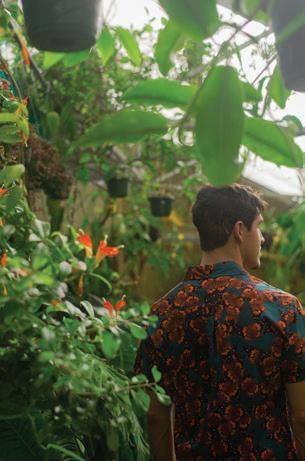

Through Shepard’s deft hand, their stark white blooms and silvery green leaves are on lively display as if caught mid-breeze. Often found growing among lava rocks along the coast, to Shepard they signified the “history of human endurance and compassion in the face of daunting circumstance,” a nod to the Kalaupapa patients who first inspired him.
It’s quite a fitting meaning to ascribe to his first design as Shepard’s road to success hasn’t been easy. As he prepared to launch his line in 2020, the COVID-19 pandemic hit, effectively putting his plans on an indefinite pause. What was meant to be his debut event, the 2020 Merrie Monarch Festival, was canceled and wouldn’t return until a year later.
Perseverance and a shade of luck, though, landed him on the New York Times in a spotlight featuring his line of botanically inspired face masks. Almost instantly, he became a household name. Everyone from politicians to local journalists began sporting a Shepard shirt.
Faithful to his original mission, each one was accompanied by a tag detailing the endangered native plants and animals featured on its print. He began collaborating with local conservation groups, raising donations through his sales. Gradually, his goal of aiding conservation efforts was realized.
Then, in late 2021, another set back. After months of migraines and sleepless nights, his doctor delivered a brain tumor diagnosis. By then, Shepard was working on his clothing line full time, supplying eight retail stores across the islands along with his own e-commerce site.
For the next six months, he was on the slow path to recovery. Looking back, Shepard sees that time as influential but not defining.
“You know, none of this is about me,” he says, his voice trembling. “I’m honoring the legacies of what came before me, the kind of community that I love and want to represent in the most authentic way possible.“
As his brand grows, Shepard also has authentically helped lift up the LGBTQ community in Hawai‘i, regularly hiring queer talent, including models and photographers, to showcase his designs.
Sentiments of legacy, undoubtedly, ran through his mind on the night of the Merrie Monarch as he saw his designs on stage. Poignantly, it was the same pua kala print that he drew to launch his clothing line except this time they were on the world’s biggest platform for Hawaiian culture.
“I feel myself getting emotional when I say this, but I see myself as just a vehicle for all this to flow through,” he says. “Whatever talents I have, it’s in the service of this purpose that is greater than me.”
94
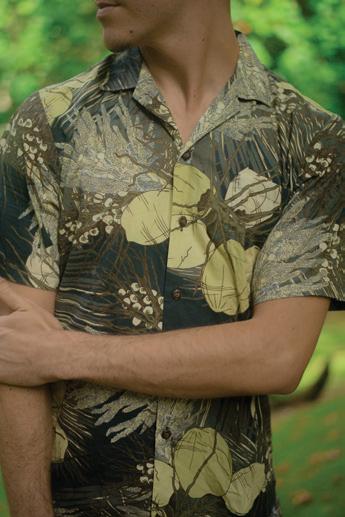
For illustrator Matt Miller, helping architects and interior designers embrace the look of a destination is key to bringing projects in cities like Washington, DC, and Tampa to life.
After designing the interiors of luxury homes in Washington, D.C.’s Georgetown and Tampa’s Hyde Park neighborhoods, it’s no wonder Matt Miller has a soft spot for historic architecture. His work mixes classic elegance with modern sophistication that preserves the past while welcoming in a bright future for its owners.
After graduating from Virginia Commonwealth University with a Bachelor of Fine Arts degree in Interior Design, Miller spent eight years working as a lead designer and project manager on multiple residential and commercial interior design projects, he launched Perspective, in 2018, as his own art studio dedicated to providing high quality hand-drawn renderings for interior designers, architects, and builders in order to help sell their vision.
Naturally, travel has enabled Miller to appreciate how each city he visits looks and take in the differences—the little details— so that he can better understand the design projects he’s tackling, no matter the destination. Those have included detailed renderings for a modern estate in Nashville, a pool area in Los Angeles, and home in historic Charlottesville, Virginia.
“Travel keeps my creativity fresh and inspires me to do new things,” Miller says. “I learn about how other people in other cultures or other parts of the world live, and afterwards I’m inspired to try to incorporate some of those things into my own life at home.”
Miller’s been charmed by Cartagena, Colombia, and recommends everyone visit Paris at least once “just to see the city layout, monuments, and architecture. It really lives up to the hype.”
WORDS BY MARC GRASER IMAGES COURTESY OF MATT MILLER
DESTINATION BY DESIGN 96


We connected with Miller after his second trip to the Côte d’Azur in the south of France with his husband, Bryan. “I’d happily move there if I could,” says Miller, who is drawn to sunny locales like the Dominican Republic, Bermuda and Puerto Vallarta when traveling. You won’t often find him without sunglasses to protect his eyes or cover them “when I’ve overindulged on food or drinks the day before!”
One of Miller’s vices is exploring a city through its culinary culture: “I love to eat good food and drink good wine or cocktails, and if they happen to serve that in a beautiful space, I’ll make it a point to be there,” Miller says.
“Not to be cliche, but my honeymoon with my husband had some of my favorite travel memories,” he recalls. “We were in the French and Italian Riviera for two weeks, and one of my favorite memories from that trip was stumbling on this super old villa that had been turned into a bed and breakfast with a restaurant on the ground floor. There was hardly any cell service and no WiFi. It was on Elba Island and overlooked the Mediterranean, and they served us the most amazing charcuterie board I’ve ever seen. I don’t think I’ve ever been so full in my life afterwards.”
Miller cites a move to Washington, DC, when he was 22 as one of his proudest moments. “I definitely could not afford it and racked up a lot of debt the first year I was there, but I think it opened so many opportunities for me in my professional life and in my personal life.”
In addition to successfully growing Perspective, he’s also become a children’s book illustrator.
He partnered with fellow LGBTQ entrepreneur Brandt Ricca on “Barris and The Prince of Rappa,” which debuted in October 2021, and will soon span six books. Travel, history, and discovery of new places
are at the heart of the books’ story and characters that revolve around a boy and his three sisters who have just moved from DC to New Orleans.
Don’t they say to write what you know? For Miller, it’s also about designing through inspiration, and an appreciation for diversity and responding to adversity.
“I think travel inspires you to do more and change things up in your life,” Miller says. “After coming back from this trip to the south of France, I decided I want to get my boating license. I definitely didn’t really have that in mind before the trip.”
To gain further insight into his craft, we asked Matt about his approach to designing spaces in cities like DC and Tampa, where he splits most of his time.
What does Tampa look like when it comes to design? What are its colors, textures, overall aesthetic.
matt When it comes to design, Tampa embraces its place in nature. When I first moved to Tampa in 2016, one thing that surprised me about the city was how much of its history is still preserved (Ybor City, Hyde Park, Downtown). You can find a sunroom and lots and lots of windows on almost every craftsman home in historic Hyde Park.
On new builds, outdoor space is almost as important as indoor space. We are in the sunshine state, and even on the new builds that I see and that I have worked on, letting the outdoors in is prioritized.
Additionally, natural materials like stone and wood are key for me when I’m designing a space in Tampa, and I like to tie it all together with organic shapes, a neutral palette with heavy textures (like boucle and sisal), and bold artwork.



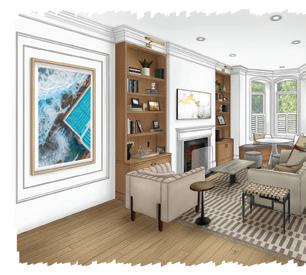
How would you describe Washington, DC, in that same regard?
I would say DC is more eclectic in design. DC is a sister city of Paris, and I think we like to emulate that in designs here. At least I do.
There is so much beautiful historic architecture here and if it hasn’t been preserved, I try to bring it back as best as possible and have the paint colors, light fixtures, and some of the furniture be a nod to the space’s history.
To finish the space, I like to mix in modern organic shapes and pops of bold patterns or colors.
How important is establishing a sense of place in your work?
matt I think it’s incredibly important. I try to design a space that I would want to spend time in myself. It can look pretty, but if it doesn’t feel inviting and warm, I’m not into it.
I think including natural materials along with interesting textures and visual elements creates a rich and inviting space. When I’m finished with an install and I want to stay and hang out (or move in), I know I’ve done a good job.
What are some of your favorite projects and how do they reflect your work?
matt I worked on a rowhouse renovation in Washington, DC’s Logan Circle, in 2019, and I was so happy with how it turned out. The house had a lot of its history preserved, but some of it had been torn away.
We brought it back by opening up fireplaces that had been drywalled over (there were 11 in the house total), restored crown moldings
and door trim that had been poorly altered or repaired, and brought back a color scheme that seemed to fit the style of the house, as opposed to the bright white that was everywhere.
The client also wanted to have some fun with the design by adding what he called “drama” so we gutted the beige kitchen and added in new, dark blue and gray cabinetry on a new black and white marble tiled floor.
We also had custom light fixtures designed to compliment the gigantic mirrors above the two fireplaces in the dining room and living room, and painted a diamond pattern on the foyer floor.
What would you say is your signature look?
I worked on another project (also in Logan Circle) last year that I loved. The clients were fun, young newlyweds and they wanted their first place together to reflect their personalities. It was a modern space but pretty dull.
To add life, we added a two-story Noir Blanc marble wall above the fireplace, installed two-story floor to ceiling sheers for the large windows, replaced the cable wire railings with glass, added a bar in the second floor den, and added lots of fun wallpaper in the bathrooms.
We also painted the kitchen floor to look like black and white tile marble, so I guess that might be one of my signature looks.
102

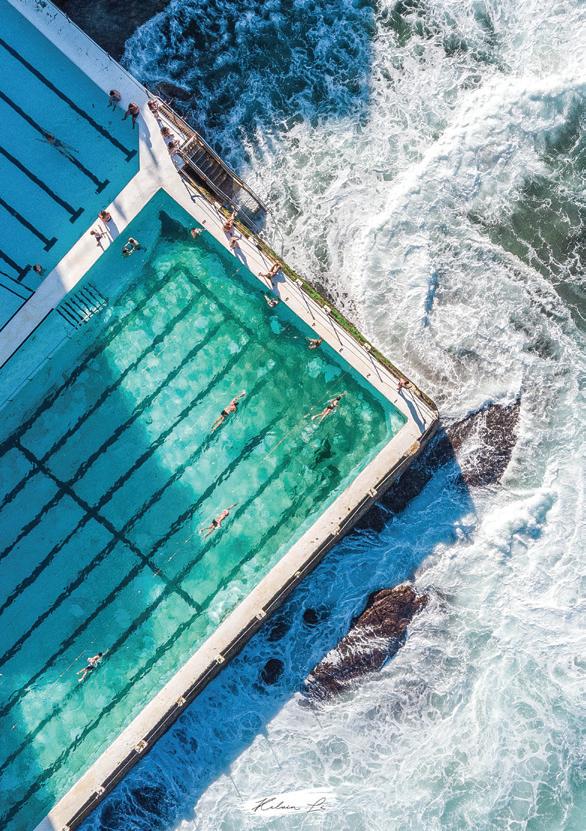
III. Explore
Connect with locals who see their cities as maps to self-discovery
Thanks to the appeal of cities like Paris, Barcelona and New York, the three most visited countries in the world are usually France, Spain and the United States, according to the United Nations’ World Tourism Organization.
Despite these places having a reputation for being LGBTQ-friendly, we wanted to recommend five other unique places queer travelers should consider when planning future trips.
With an estimated 180 million LGBTQ travelers set to explore the world by 2030, these destinations offer unforgettable experiences, opportunities to connect with local queer communities and participate in inclusive events and festivals in a safe and accepting environment.
While these places have a reputation for being LGBTQ-friendly, it's always essential to remain respectful of local customs and laws to ensure a positive and enjoyable travel experience.
WORDS BY MARC GRASER
106 FIVE GREAT ESCAPES
IMAGES BY RAMIRO COLLAZO, TARYN ELLIOTT, ALEC FAVALE, TOBIAS REICH, AND JULIA SOLONINA


While the classically beautiful cities of Lisbon and Porto are typically on the list for any traveler visiting Portugal, the stunning sun-drenched coastline, scenic limestone cliffs and golden beaches of the Algarve should also be included on any future itinerary.
While the classically beautiful cities of Lisbon and Porto are typically on the list for any traveler visiting Portugal, the stunning sun-drenched coastline, scenic limestone cliffs and golden beaches of the Algarve should also be included on any future itinerary.
A scenic three-hour drive from Lisbon, the Algarve is an attractive destination for nature enthusiasts located in the southernmost region of Portugal, and bordered by the Atlantic Ocean to the south and west.
It’s a coastal paradise where LGBTQ travelers will find themselves warmly accepted, and experience a vibrant cultural scene. That’s especially true in the charming towns and villages of Albufeira, Faro, Lagos and Portimão, where you can relax and catch the sunset over glasses of chilled Vinho Verde and meals of freshly caught seafood from local Michelin-starred restaurants and bars.
Portugal is known for its delicious red wines, and you can find a variety of them in the Algarve.
Look for wines made from grape varieties such as Touriga Nacional, Trincadeira, and Aragonez (also known as Tempranillo). The country’s whites, like Alvarinho, Arinto, and Antão Vaz are also excellent.
Unlike Europe’s Ibiza and Mykonos, the more budget-friendly Algarve hasn’t established itself as a popular gay destination just yet. But it’s equally worthy.
In general, the Portuguese people have a reputation for their warm hospitality, embracing diversity and treating travelers with respect and open-mindedness. The Algarve’s fourth Pride parade was held this year in Faro.
Known as one of the sunniest regions in Europe, Algarve’s Mediterranean and Atlantic climate gives it pleasant weather throughout the year.
You’ll find the best beaches with incredible rock formations in Praia da Rocha, in Portimão, and Praia do Trafal, in the working class town of Quarteira, where you’ll find a more authentic experience away from the three upscale resort communities that make up the region’s Golden Triangle: Quinta do Lago, Vale do Lobo, and Vilamoura.
Alvor, Lagos and Tavira are where gay travelers will want to stay, as these are the towns with gay-friendly beaches, including the secluded Praia João de Arens.
One day trip worth taking is a boat to the Benagil Caves, an iconic local sight you can only access by water. There you can bask in the sunlight that streams through the hole in its roof.
GREAT ESCAPES: THE ALGARVE, PORTUGAL
GREAT ESCAPES: CAPE TOWN, SOUTH AFRICA
You won’t look at a world map the same again after you’ve stood at the southern tip of Africa, taking in where the Atlantic and Indian oceans meet; wake up to the roar of lions in the savanna; or sip a glass of Cabernet Sauvignon in South Africa’s beautiful wine country.
All of that is accessible not far from Cape Town, a dynamic city on the shore of Table Bay, and a great place to start exploring the African continent if you’ve never visited before.
With its coastal beach vibe and friendly locals, Cape Town is like San Diego, just with the massive Table Mountain cutting through it. It’s socially progressive, diverse and inclusive, making it ideal for LGBTQ travelers.
This ruggedly handsome city boasts a number of popular LGBTQ-owned or friendly bars, clubs, and entertainment venues, and hosts queer festivals year round, and Cape Town Pride around the beginning of March.
De Waterkant, with its historic Cape Dutch architecture and trendy hotels and entertainment offerings, is essentially the epicenter for the LGBTQ+ scene in the city. Nearby Green Point is also popular, and home to Cape Town Stadium, built for the 2010 FIFA World Cup, where you can also catch a rugby match.
After taking in the spectacular views from the top of Table Mountain, explore the beauty and diversity of Kirstenbosch National Botanical Garden. You’ll also want to visit Clifton Beach, which is actually made up of four beaches, with the third a haven for LGBTQ sun seekers.
While Cape Town’s Mediterranean climate of dry summers and cool wet winters doesn’t lend itself to the traditional African bush experience, the Big Five—lion, leopard, rhino, elephant and buffalo—are only a couple of hours away. Aquila, Inverdoorn and Sanbona are three highly recommended wildlife reserves that offer safaris and allow you to stay overnight close to the animals.
For wine lovers, Stellenbosch, located near the Cape Fold Mountain range, and a 90-minute drive from Cape Town, is home to numerous vineyards and wineries, offering visitors the chance to experience tours and tastings of world-class wines.
While Reverie Social Table, Mzansi and Bell of the Beast are some of the city’s top restaurants, offering local flavors and dishes, adventurous eaters will also enjoy sampling goat head; eland, springbok and kudu antelope; crocodile tail; and ostrich at Mama Africa.
110

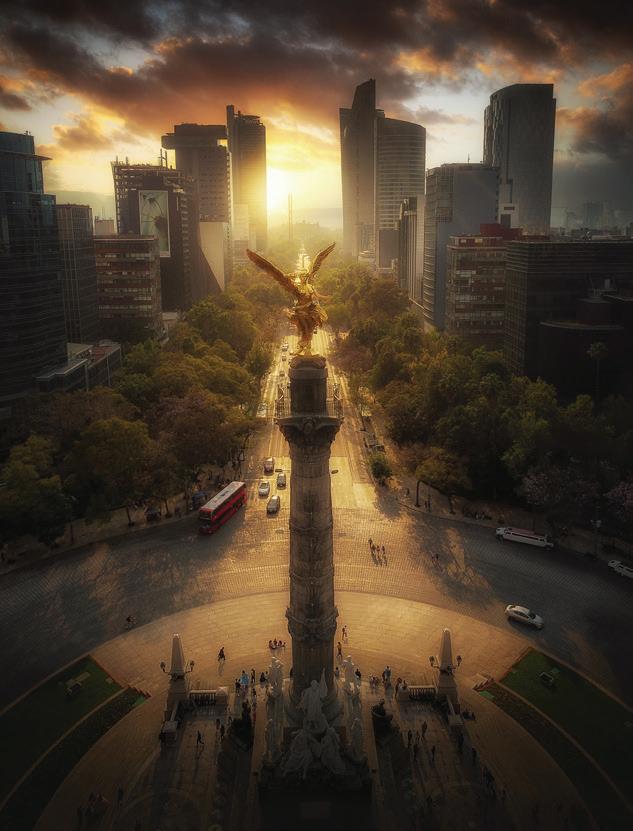
Speak to anyone who has visited Mexico City recently and the response is always effusive and resoundingly enthusiastic, making it a reason we’re recommending it as a worthy place to spend time exploring, even if it’s a layover before hitting the popular beaches in Puerto Vallarta, Los Cabos, Riviera Maya, Tulum, or the “Gay Capital of Mexico” in Jalisco, Guadalajara.
Despite the country being deeply conservative, North America’s largest city offers a vibrant LGBTQ nighlife scene, exceptional restaurants and cultural experiences.
There’s a creative vibe that feels like it’s taken over and helped revitalize the city, mixing modern developments with respect for historic culture in a way that feels fresh and inviting.
“As the first major Latin American city to legalize same-sex marriage (way back in 2010), Mexico City has long been a hub for LGBTQ travelers looking for liberal, big-city sophistication,” according to queer traveler and freelance writer Mark Chesnut.
Given its affordability, interest in Mexico City increased dramatically during the pandemic, attracting thousands of remote workers from the United States and Canada.
With 21 million residents in and around the city, it’s no surprise that the city’s annual Gay Pride Parade, in late June, is the largest in North America, attracting millions.
Yet no matter when you visit, you’ll want to explore the upscale neighborhood Polanco for some of the most renowned places to eat, including Enrique Olvera’s award-winning Pujol, with its omakase of tacos.
Nearby are the Jumex and Soumaya modern art museums, the latter of which is wrapped in a skin of mirrored hexagons. You’ll find Casa Azul, the former home of Frida Kahlo in the southern neighborhood of Coyoacán.
Enjoy some freshly baked churros in the center of town at Chapultepec Park, home to the Anthropological Museum’s collection of Mayan and Aztec relics; the Tamayo Contemporary Art Museum; and the Chapultepec Castle.
Zona Rosa, with its pink-colored cobblestones and legendary BGay BProud Café, is the city’s hub for all-things LGBTQ. Cafe culture is strong in the neighborhoods of Condesa and Roma, and hosts the city’s underground queer scene. See Diego Rivera’s oversize murals in Centro Historico. And yes, drink bottles of aged tequila at a mariachi bar, or go salsa dancing, and cheer on colorfully costumed Lucha Libre wrestlers for that authentic local experience.
And if you have time, take a 90-minute drive north to explore the incredible ancient ruins of Teotihuacan.
GREAT ESCAPES: MEXICO CITY, MEXICO
There’s
a
saying
in Puerto
Rico: To Live Boricua means to follow your heart wherever it leads you and find freedom around every corner.
Puerto Rico has long been a gay-friendly Caribbean island and one of the most accepting destinations, with same-sex marriage legal since 2015, for its more than 3 million residents.
It’s about time Puerto Rico deserves some love, especially from LGBTQ travelers, when its largest city, San Juan, celebrates the community with two large Pride parades and festivals during the first two weeks of June.
The parties start with San Juan Pride, which fill the bars along Calle Condado and beach clubs at Condado Beach.
Following is the Cabo Rojo Pride festival, hosted by a sleepy coastal town with 18 pristine white-sand beaches nearby.
You’ll pretty much be accepted everywhere, but San Juan has three LGBTQ-friendly neighborhoods that are at once foreign yet familiar: Condado, Santurce, and Ocean Park, trendy upscale neighborhoods of hotels, bars and restaurants.
Here you’ll find La Casita Blanca, or “The Little White House,” with an authentic menu and elevated dining room that local influencers flock to. If you order anything local, make sure to try mofongo, Puerto Rico’s popular mashed mix of garlic seasoned fried green plantains filled with vegetables or meat.
San Juan is compact, so you can explore much of the city in a few days. Plan to stay in one of the most popular neighborhoods, each with a distinct vibe: Condado, which is central; Old San Juan, with 500 years of history and colorful Spanish colonial architecture; or Santurce, a grittier hub for vibrant street art, James Beard-nominated
restaurants and colorful nightlife. The Eleanor Roosevelt district is especially popular with San Juan’s many university students, who gravitate to bars like El Cojo, A Pedir De Boca, and La Esquina de Polo.
There are two gay beaches in San Juan: The popular Atlantic Beach, in Condado, and Ocean Park Beach, in Santurce.
For day trips, consider the mostly secluded Vieques island, off the eastern coast, a nature preserve where you can take boat tours of Bioluminescent Bay (or Mosquito Bay), with microorganisms giving its water a blue-green glow.
114
GREAT ESCAPES: SAN JUAN, PUERTO RICO

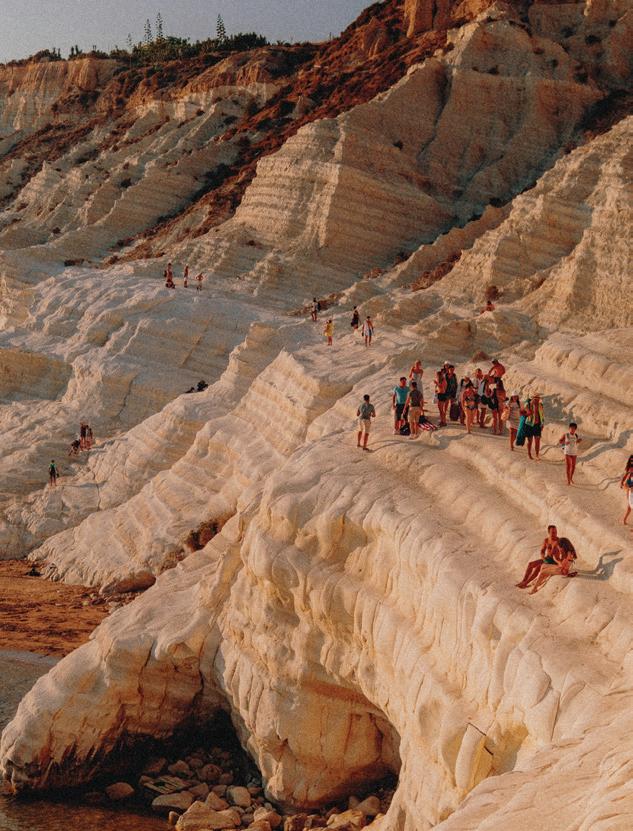
We’re all about set jetting right now: Getting wanderlust and visiting a destination that was prominently featured on TV or in the movies.
Italy is especially hot this summer, with Rome and Venice getting the spotlight in the newest “Mission: Impossible,” “Indiana Jones” and “Fast & Furious” movies. But it might be Sicily that has us wanting to take a closer look in person thanks to our infatuation with HBO’s “White Lotus.”
Sicily’s picturesque and historic seaside towns of Palermo, Noto, Catania, Modica, Siracusa, and Giardini Naxos are LGBTQ friendly and offer a lot for the curious traveler on the largest island in the Mediterranean Sea, with Mount Etna, one of Europe’s highest active volcanoes, towering above.
In addition to lounging on the sandy beaches and swimming in the azure blue waters, you’ll want to roam the winding roads and timeless rural towns of the countryside.
The overall vibe of the region is relaxed Mediterranean, and you’ll find long sandy beaches on the northern part of the island. They get rockier around the remote fishing villages dotting the southern point. Oasi di Vendicari offers a laid back gay friendly nudist beach, not far from Noto.
The Four Seasons resort featured in “White Lotus” is the San Domenico Palace, in Taormina, generally considered the top LGBTQ travel destination in Sicily, and a great home base for exploring the island.
A stunning point of interest that should be on anyone’s must-visit—and a site that hasn’t been overshared too much on social media, is La Scala dei Turchi, or the Turkish Steps, a blinding white cliff of limestone and clay that rises above the Strait of Sicily.
The food, of course, is a major attraction. “That’s why I love going back to Italy every year,” says queer comedian Matteo Lane, who effusively promotes Italy in his standup and YouTube videos. “I can’t believe an entire country eats pasta every day, knows how to properly eat pasta, and makes the best pasta in the world. It’s like heaven to me. It’s like Disney World.”
After spending hours lounging by the sea, make sure to sample Sicily’s exceptional regional dishes, including the vegetarian-friendly pasta alla Norma, a mound of sautéed eggplant tossed with tomato sauce and topped with ricotta salata. Try busiate, spiraled spaghetti-like pasta, originally from the seaside city of Trapani, and cassata sponge cake at Caffè Sicilia, heralded as the best café in Italy, also in Noto.
Don’t worry about how you’ll look in that bathing suit. People in Sicily “have no shame,” according to Lane. “They love being tan, love being in Speedos and they’re not going to change.”
GREAT ESCAPES: SICILY, ITALY
The “LGBTQ+ Travel Safety Index” has evaluated the safest and most dangerous places for queer travelers since 2019.
Journalists Lyric and Asher Fergusson, behind the travel site Asher & Lyric, regularly reviews the individual laws of 203 countries, including protections against discrimination, criminalization of violence, illegal same-sex relationships and more. Sources include Human Rights Watch, the Gallup World Poll and the International Lesbian, Gay, Bisexual, Trans, and Intersex Association. Here are their results for 2023.
20 Safest Countries For LGBTQ Travelers
Canada
Sweden
The Netherlands
Malta
Norway
Portugal
Spain
Denmark
United
Belgium
Kingdom
France
Iceland
Switzerland
Ireland
Luxembourg
South
Africa
Germany
Chile
Uruguay
Austria
20
Lowest Ranked Countries For LGBTQ Travelers
Brunei
Saudi
Arabia
Nigeria
Kuwait
Malawi
Guyana
UAE
Malaysia
Sudan
Libya
Yemen
Oman
Mauritania
Somalia
Gambia
Afghanistan
Qatar
Tonga
Tanzania
South
Sudan
WORDS BY MARC GRASER IMAGES BY MARCIN SKALIJ 118 GREAT ESCAPES
1 2 3 4 5 6 7 8 9 10 11 12 13 14 15 16 17 18 19 20
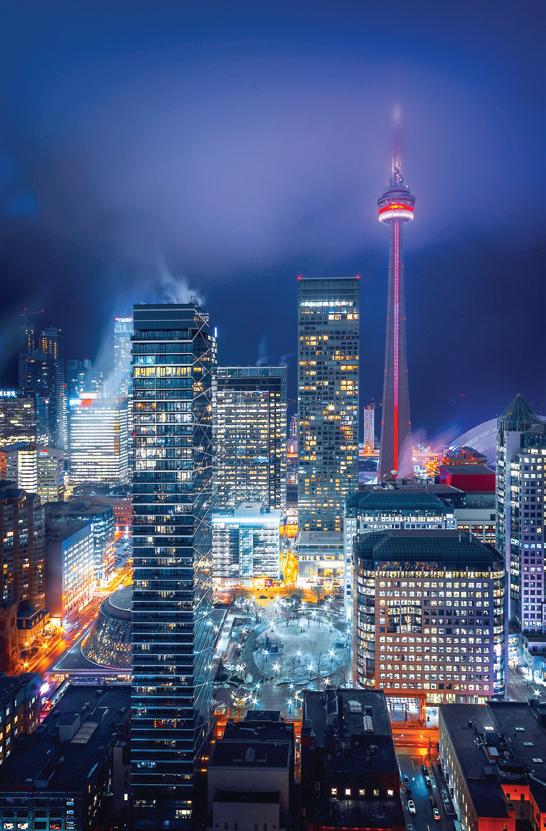
Hospitality comes naturally for the founders of Residents, a cafe that rose in popularity in Washington, DC during the pandemic.

WORDS BY MARC GRASER IMAGES COURTESY OF HAWKEY JOHNSON
120 ESTABLISHING RESIDENCY
The moment you step into Residents, you feel welcome. You’re greeted, no matter how busy the staff is. You’re treated like a guest in someone’s home. You’re seen.
That should be the norm, but in today’s digitally distracted world, true customer service is inconsistent. That didn’t go unnoticed by Serbian transplants Radovan Jankovic and Marko Bogdanovic when they partnered to open their first cafe in Washington, DC’s lively Dupont Circle, in 2019.
The result is Residents, a winning concept of a cafe, restaurant and bar that serves an inventive list of cocktails and food menu of European-inspired fare. What first opened as an intimate but comfortable bar that mixed a mean espresso martini is now a must-visit restaurant for the Instagram generation thanks to its inviting patio, one of the city’s best outdoor hangouts, no matter the season.
Residents was always meant to emulate the kind of cafes you find in Europe, catering to different customers throughout the day: college kids and professionals in the morning, a more casual set during the day, and the dinner and cocktail crowd in the evening—all attended to by a disarmingly unpretentious staff who actually enjoy their jobs.
Happy hosts result in guests that are taken care of, which was always top of mind for Jankovic, a former model with handsome movie star looks, who got a crash course in hospitality from some of DC’s top stars, including José Andrés, Mike Isabella and The Ritz-Carlton co-founder Horst Schulze.
While running bar programs for luxury hotel The Capella (now a Rosewood), barmini and Kapnos Kouzina restaurant, in Georgetown and further up the road in Bethesda, Maryland, Jankovic observed bartenders who hated complicated cocktails with too many ingredients, and “mixologists” offended by having to make the classics like a dirty martini. He saw cocktail bars that didn’t have the best food, restaurants with great food but disappointing drinks.
“That shouldn’t mean you shouldn’t get it,” Jankovic says. “The best product I can make for you is the one you really want. If you don’t understand that, you might be in the wrong business. Hospitality is simply creating a connection with the person that you’re serving.”
That connection was key in making Residents a success in a city that can be tough on newcomers, and then there was the brutal pandemic.
When it opened, Residents was small—a bar in a narrow room that opened up to a few cafe tables in the back. The overall vibe was cozy and bohemian with a mix of warm woods and green plants. If you’ve been to Berlin, Paris or London, you’ve been here before.
A major draw, however, was the exterior patio, an inviting space that couldn’t be used during much of the year because it was exposed to the elements.
“Covid was definitely interesting for us,” Bogdonavic recalls. “Once everything started collapsing, we took a minute to think about what we should do.” During the pandemic, “people wanted to be more spread out. People wanted to have more space. They wanted more airflow.”
The solution was to cover the patio, and with the city’s approval and the cooperation of a neighbor, Residents more than doubled the size of its outdoor space.
“It ended up being five times bigger than what we have inside,” Bogdonavic says. “At that point, Residents became a restaurant instead of a bar.”
“Once we covered everything, that helped us be what we are today,” Jankovic adds.
Whereas other restaurants quickly erected plastic tents or temporary coverings, Residents opted to use thick wooden beams for its structure and more durable roof, making it look like a natural extension of the restaurants’ facade, but also elevated. Heat lamps warm the space during colder months.
The structure also enabled Residents to get creative with seasonal themes — colorful leaves and blankets in the fall, Grass, bamboo trees, Korean pines, shrubs and other greenery in the summer — creating a mood. “We became plant freaks,” Jankovic says.
That certainly paid off. It was Spring that helped put Residents on the map. Tourists make their annual pilgrimage to DC to view the city’s cherry blossoms, but were disappointed during the pandemic when DC down the entrance to the monument lined Tidal Basin to prevent crowding.
Unable to go to one of the city’s most picturesque spots to view the rows of cherry blossom trees and take selfies, visitors and locals found their way to Residents, which had happened to decorate its new patio with the pink and white flowers.
Guests quickly spread the word on Instagram that there was a pop up celebrating cherry blossom season, “and the whole city started showing up,” Bogdonavic says. “We never thought of it as a pop up, we just wanted to have decor for our patio. The cherry blossoms, I love them so much because they took our restaurant from 50% to 100%. That’s when the masses started learning about Residents.”
Residents’ food menu is influenced by international flavors from Germany, Greece,
122
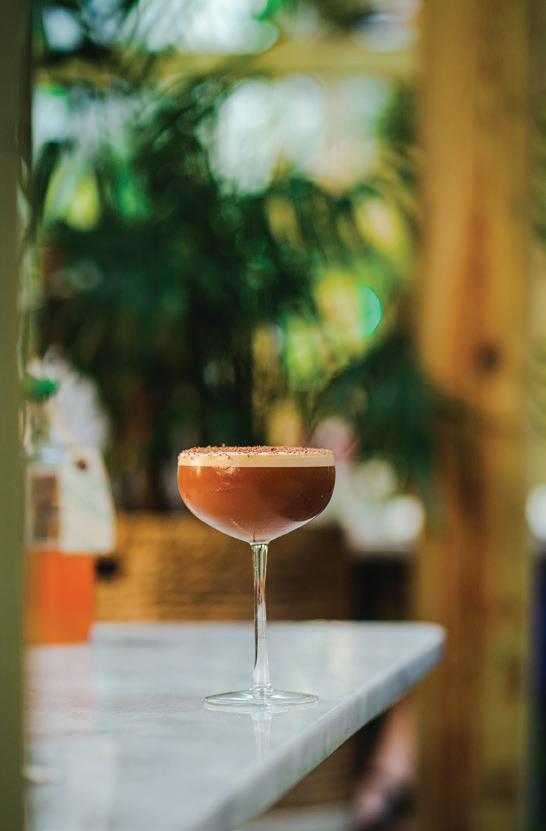

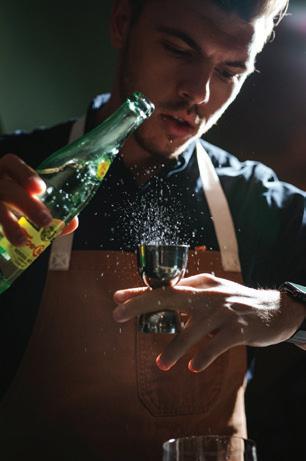

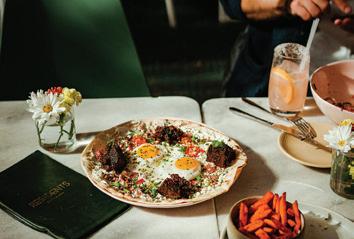
Italy and Turkey, with apple strudel, schnitzel, carbonara, garlic labneh and feta, charred octopus, mini gyros and basque cheesecake.
The cocktail menu features photogenic seasonal cocktails that are fruit forward with mandarin, kiwi, pink grapefruit and pear. Others like the clever Bee mixes raw honey with bee wax, propolis bee resin, bee pollen, Nordic mead and Tom Cat gin.
But Residents’ most popular cocktail is the espresso martini. Residents originally offered their version in three varieties—with vodka, bourbon and rum serving as the base and each mixed with ghee clarified butter as a twist. The one with vodka won out as the ultimate version, and is now the pride of Residents’ founders, and the cocktail Jankovic and Bogdonavic believe fueled the espresso martini trend in DC.
“If you combine all the other cocktails together on the menu, they don’t reach the number of espresso martinis that we sell throughout the week,” Bogdanovic says.
Staying on top of trends is another important lesson Jankovic learned over the years. “Feedback is crucial,” he says. “The clientele is always changing and you have to constantly listen to what people like because the trends are always changing. If you don’t, you fall behind.”
From the start, Jankovic and Bogdanovic always focused on attention to detail, and “wanted to approach customers on a human level,” Jankovic says. “You should acknowledge that they’re there and offer them a seat, offer them a glass of water, just ask them if you can help out somehow.”
While other names were considered, Residents just felt right. From its owners to its investors and staff, Residents boasts a mostly international team. “We’re mostly foreigners, but we are all residents of this city,” Jankovic says. “We wanted to create a vibe that felt like home. Everything comes down to that.”
“People come back to Residents time after time because of the relationship that we create with the customers,” Jankovic adds. “When you really take the time to have conversations, you create that connection. It’s very, very powerful.”
126

As photographers, Leslie and Tanner Dam couldn’t help but make their nuptials look amazing with a stunning backdrop.
Originally the plan was just to celebrate the holidays with our family in Sacramento, but Tanner and I love to seize our opportunities and it turned into “let’s make it official and get married!”
We wanted it to be a small dinner with our family as a celebration, but of course with such an amazing, supportive, and loving family, a small gathering to witness the signing of our marriage certificate turned into a ceremony with wedding vows, lots of food, and a lot of yelling and screaming with excitement and joy. It was the perfect wedding and really reflected who we are as a couple.
Believe it or not, our relationship started with a trip together. With Tanner living in Hawai’i and me in California, we met in person for the first time in San Francisco, about half a year after I “slid in his DM’s.” After our long weekend together, we decided to take our chances being in a long distance relationship and we’ve been together since then. That was four years ago.
For us, traveling is always a balance between our “must-dos” and things we can sacrifice if we’re no longer up for it.
Luckily for me, Tanner is always good with research, creating the itinerary, and having a list of things to fall back on.
Most important is just make the best of it, take the rest if you need it. When it’s safe to do so, public transportation or walking will definitely help you see more of the city or country you’re visiting.
AS TOLD TO MARC GRASER BY LESLIE DAM IMAGES BY LESLIE AND TANNER DAM 128 COUPLE CONNECTION WORDS BY MARC GRASER IMAGES BY MARCIN SKALIJ

One of our favorite travel destinations is Osaka, Japan. Between seeing all the animals, historic sites, our frequent stops at 7-Eleven and Lawsons, and the multiple geek shops, we absolutely love the culture and the hospitality.
I would have to say one of my favorite memories of our travels is going to Hakone, Japan. It was during the winter season and we got to experience the quietness of a more rural area. After spending a few days in Tokyo and Osaka, being in Hakone to just lay back and relax was refreshing. Not to mention the onsens really helped with recovery.
My trip to Bangkok was the most surprising trip I have ever taken. Not really knowing what to expect, I always thought Thailand was all about temples and street food. What I found was how much more of a city it was—a lot of shopping malls, the hustle and bustle, and their love for fashion. But this is why we travel! We get to learn more about other countries and cultures that we don’t get to experience a lot of unless we’re there.
Don’t be discouraged about places you hear that don’t accept us. Unfortunately, this is something we always have to be conscious of, but for my LGBTQ travelers, always know where our safe spaces are. We can be completely blindsided and think even though the majority of the places aren’t as “progressive,” or LGBTQ friendly, there are a lot of places that have small communities that will welcome us and where you can be yourself and have a great time! Find the places that give us the freedom to feel safe in. Those are the most rewarding experiences and you’ll make a lot of friends along the way that will always welcome you back.
As an LGBTQ+ veteran and small business owners, we are always seeking ways to grow and inspire others.
Tanner is currently working on his artwork which comes in the form of enamel pins (stickers and other goodies soon to come), and I am rebranding my photography and videography business, Dam Fine Media, that caters more to the Los Angeles market, while continuing to work in the film and entertainment industry. You can check us out on instagram at highend.pins and damfinemedia.
We asked Leslie and Tanner about some of their favorite photos.
LAKE CLEMENTINE, CALIFORNIA
Tanner and I had planned on doing a small paper signing ceremony with the family in Sacramento while we were there to spend the holidays. Since we were going to wear suits and have our leis for the ceremony, we wanted to also take our wedding photos. We’ve always had easy access to beautiful waterfalls in Hawai’i, so we had to find something we thought was just as breathtaking and immediately remembered this hike in Lake Clementine, which is a 45-minute drive from Sacramento, had done before my move to Hawai’i.
The photos were taken in December, so being in California and closer to the mountains, it was cold. But the view was amazing and we felt good being in our suits. It was a happy day for the both of us. Being photographers ourselves, we just brought
130
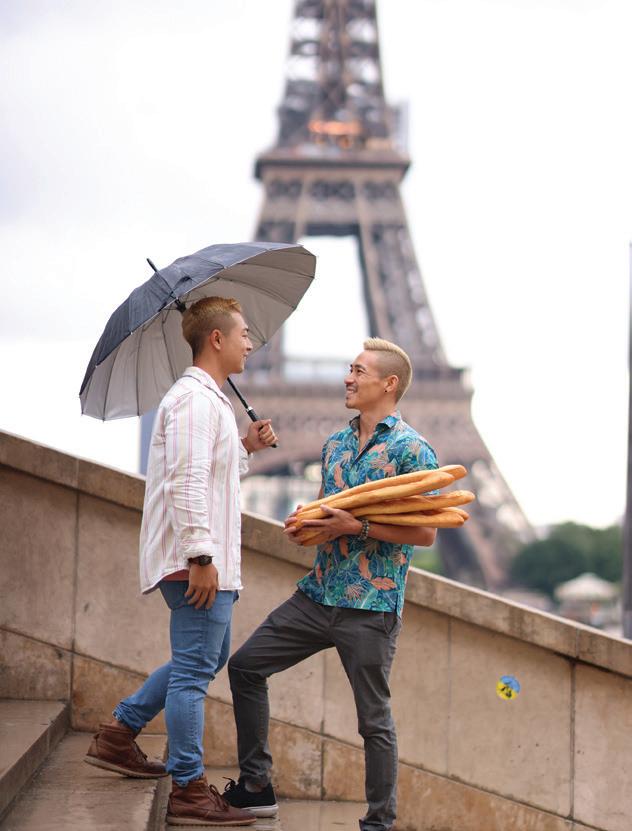

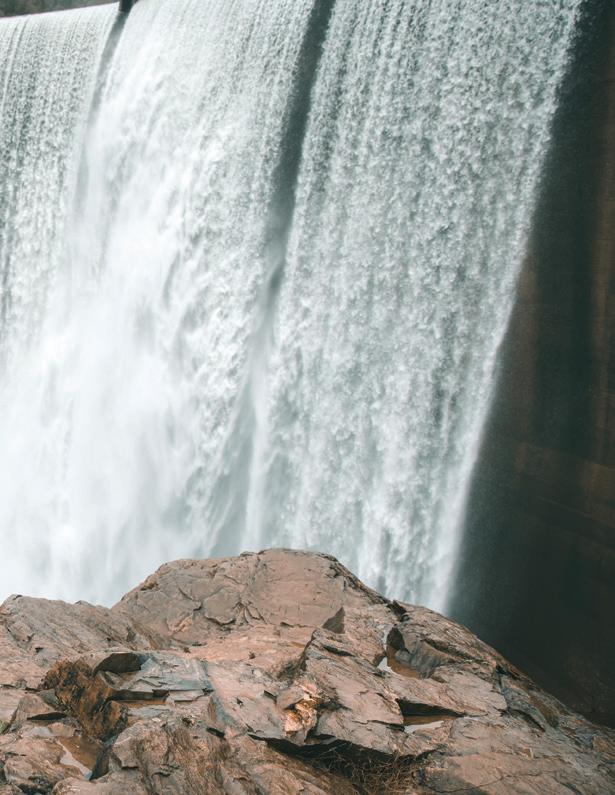

our camera and tripod and took the pictures. With whatever feelings we had left in our fingers from the freezing cold and the mist from the waterfall, we managed to capture these incredible photos.
I would definitely recommend this hike for anyone who enjoys nice forest and mountain scenery, especially when visiting Northern California. It’s a whole different view than if you were closer to the coastline. The hike itself is fairly easy and you get to walk along the lake.
PARIS, FRANCE
We took this photo in Paris when we went to Europe with our siblings. Known as the City of Love, obviously we had to take a picture with the Eiffel Tower as our backdrop. And of course, we love our props, as well, so we had to make a quick stop at the local bakery to get some baguettes beforehand. It was raining that day and we only had our 85 mm lens, so the shot was tricky, but we made it work, and have to say we are happy with how the photos came out. There’s even a black and white version, kind of like those old portraits of Paris you see at random retail stores that always have a black and white version. If you enjoy espresso, croque madames (best thing ever) and art, Paris is the place you want to visit.
TSURUMI RYOKUCHI PARK, JAPAN
We took this at Tsurumi Ryokuchi Park in Osaka, Japan, during our second time visiting Japan together, and we’re itching
to go back again. The last time we were there was December, so during this visit we wanted to take advantage of the spring season by visiting a place where we could see the lovely flowers. This photo represents just how we are no matter where we go. Holding hands, walking, and just admiring everything. It was a nice place to just relax and enjoy the view. I absolutely recommend anyone heading to Osaka for their next trip to visit this place, especially if it’s during springtime. Get away from the hustle and bustle of city life and just enjoy a stroll in the park. Not that it won’t be busy there, but it’s a different vibe and feel.
The creators of On Airplane Mode inspire the LGBTQ community to travel safely and see the world through their lens.
When Kirstie Pike and Christine Diaz first met at the Gansevoort Rooftop bar in New York City, they spent the entire date talking about their love and passion for seeing the world, being introduced to new people and cultures, and experiencing new adventures. Six years later, they have explored more than 40 countries together and are the creators of On Airplane Made, one of the fastest growing platforms for women and LGBTQ travelers.
“We wanted to help people explore their sense of adventure without fear while truly celebrating their individuality … and live their lives to the fullest,” says Diaz, who is originally from New Jersey and grew up around New York City before moving to Los Angeles with Pike, a native of Tennessee.
Since launching in 2019, On Airplane Mode has built a following of more than half a million across all platforms and enabled Pike and Diaz to amplify the voices of marginalized
This is still one of our favorite images of all time because we feel it truly represents who we are by showcasing our balance of romance and adventure. This photoshoot, by Gunj Gunglani, always leaves us with a sense of freedom. At the time, we weren’t working, we didn’t have bills or anything back home to tend to. This was truly a moment in time where we could be fully present in every moment, which is something rare and we aren’t sure we will ever get to experience again.
Gunj Guglani
WORDS
BY MARC GRASER
IMAGES BY KIRSTIE PIKE AND CHRISTINE DIAZ
136 LOVE IN ALL THE RIGHT PLACES
Photo:
BALI, INDONESIA "


CINQUE TERRE, ITALY
Cinque Terre is a collection of small villages along the northern coast, and arguably one of the most beautiful destinations in Italy. This photocomes with a sense of pride and accomplishment: This was a place we only saw in movies and it was so rewarding to finally get here and experience it in real life while doing what we love.
PAGE, ARIZONA
(On the next page) We had not traveled prior to this trip for nearly a year and a half as we were quarantining throughout the pandemic. We were both so eager to get out and explore again. However, with most of the international borders closed we decided to rent a car and create our own solo road trip. We had this canyon in Page, Arizona, almost completely to ourselves— there was no one around us, the town was quiet and all you could hear was the sound of the wind as the colors shifted in the sky. It was a moment where we sat in silence with each other … realizing how grateful we were for every moment we have together and the sunset was a gentle reminder to not take life for granted.
communities, champion queer representation, and challenge societal norms, especially when it comes to queer travel.
“Individually, we have always had a love for travel,” Pike says, but were always limited to visiting a destination for a week at a time. That changed dramatically when the two spent over ten weeks backpacking through Southeast Asia together.
Wanting to document their journey as a couple, they bought a $15 tripod from a convenience store in a small village in Myanmar, and shared their experiences online. They started gaining some traction from the photos, and started receiving messages from queer families and friends who were curious about travel but didn’t know how to start, how to budget, where to go that was safe.
“It was the best experience of our entire lives and the trip that led us to finding ourselves and a desire to help and give back to our community through On Airplane Mode,” Pike says. “We quickly realized that we wanted to build our platform to inspire people to travel safely through our guides and tips. We wanted to be the representation that was, and still is, lacking in today’s media.”
A recent trip to Bora Bora, which had been on their travel bucket list, introduced Pike and Diaz to the recognition of a third-gender, known as Mahu, meaning “in the middle,” or neither male or female, in Polynesian culture.
The island of Tahiti are one of the more progressive destinations for LGBTQ+ rights and acceptance and is one of the only destinations that have never implemented any anti-LGBTQ laws.
" "

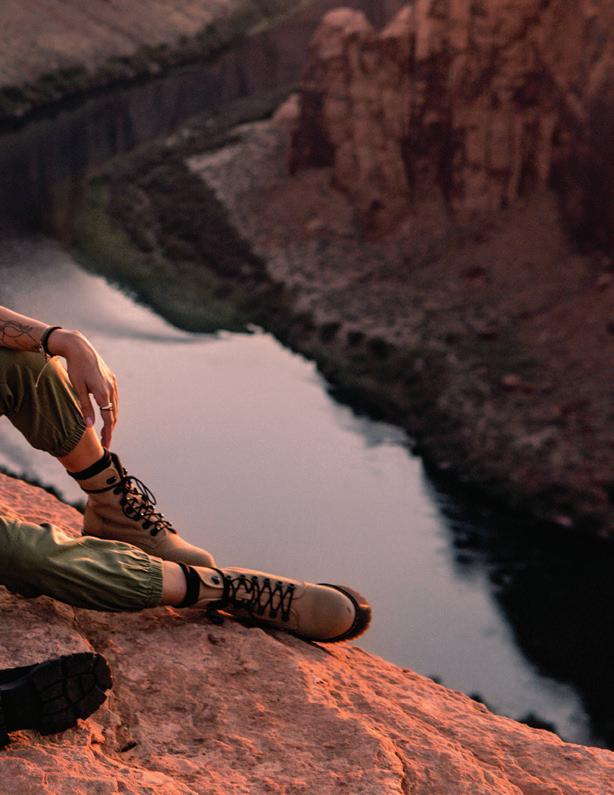
“We had Bora Bora on our travel bucket list for years and were overwhelmed with joy to finally be able to travel there,” Diaz says. “ When we arrived, we were in awe at this indescribable feeling of peace. With stunning white-sand beaches, turquoise blue lagoons and green rainforests, it is hard not to fall in love with this country but what truly made us fall in love was being seen and well received by all of the locals. We personally felt welcomed, accepted and ‘normalized.’”
Of course, that kind of greeting doesn’t happen everywhere.
“As a queer person traveling, it is so important that you do your research on LGBTQ+ safety and local laws to ensure you are aware and informed of any potential challenges or risks when visiting a new destination,” Pike says. “It’s also equally as important to be open minded, be able to adapt to cultural norms and read social cues to ensure you are traveling with respect and acceptance for other people. Understanding these norms and being mindful of local sensitivities, which can vary widely across different countries and even within regions of the same country, can contribute to a more positive and respectful travel experience.”
Jordan was an eye-opening experience for Pike and Diaz when they visited the country for the first time this year to explore the bustling city of Amman; the lost city of Petra, in Wadi Musa; trek through the iconic red deserts of Wadi Rum that you might recognize from films like “Star
" ROME, ITALY
This was Christine’s first time seeing the Colosseum in Rome in real life. You grow up hearing about this incredible historical landmark, and it certainly lived up to its glory in person. With Rome dating back to 800 BC, there is endless rich history for you to explore here.
142


"PARIS, FRANCE
Paris is such a beautiful and special place to us. It is unapologetically romantic, from the beautifully red lit cafes and awnings, the massive Eiffel Tower that twinkles at you in the evening, and the delicious food and wine that you must indulge in. We feel all of the love when we look at this photo—in love with each other, with life, with how far our passions have taken us.

During a really fun excursion driving a four wheeler through pineapple fields, we stopped at this popular viewpoint and immediately fell in love with the moment and stunning backdrop. Seeing the beauty of the island, we were reminded to make efforts to be more sustainable and preserve the natural beauty. French Polynesia should be on everyone’s bucket list.
"
BORA BORA, FRENCH POLYNESIA


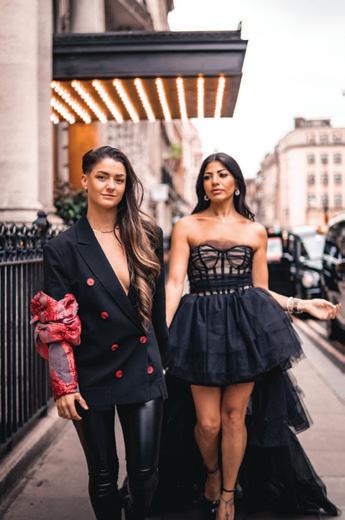
LONDON, ENGLAND
When we started, we were backpacking through Southeast Asia and had not built a following yet. Three years later, we were asked to attend the Attitude Awards in London, England, honoring LGBTQ+ trail blazers. This moment represents all of the hard work and dedication that we put into our platform and our content.
"
Wars,” “Aladdin” and “Transformers,” and scuba dive in underwater marine museums, and float in the Dead Sea.
“Jordan was certainly one of the most culture shocking destinations for us, but in the absolutely best way,” Pike says. “If you are looking for a destination where you can be out and proud as a same-sex couple, then we do not recommend this destination. However, if you are looking for a destination where your itinerary is full of adventure and seeing a world wonder, then this destination is a high recommendation.”
While the LGBTQ community is still not legal in Jordan, it is the country that shows the most tolerance for the community in the Middle East, and even has its own fan base for On Airplane Mode.
“Throughout our trip, we were receiving messages from Jordanians that were so happy to see us in their country which made this trip that much more special that we were able to be a visible representation for the queer community that already exists there,” Pike says. Jordanian people are some of the most hospitable and generous people we have ever met and you are sure to leave this country with new friends.”
Still as a safety precaution, “we were very cautious traveling as a queer couple and refrained from showing any public displays of affection,” Pike adds. They also didn’t want to attract any unwanted attention or disrespect the customs, so they paired up with a local Jordanian photographer, through
"" AMMAN, JORDAN
(On the previous pages) At the start of this year, we made the intention to travel to destinations that truly inspire us. We have always had a passion for traveling, but even more so when the destination challenges and expands our perception of traditions, culture, religion, food and more.
Photo
by Flytographer.
MO’OREA, FRENCH POLYNESIA
This was captured on the beautiful island of Mo’orea, in French Polynesia, during a really fun excursion driving a four wheeler through the pineapple fields. We stopped at this popular viewpoint on the island and immediately fell in love with the moment and stunning backdrop. Seeing the beauty of the island, we had a reminder to make efforts to be more sustainable and preserve the natural beauty of the island. French Polynesia should be on everyone’s bucket list.
148
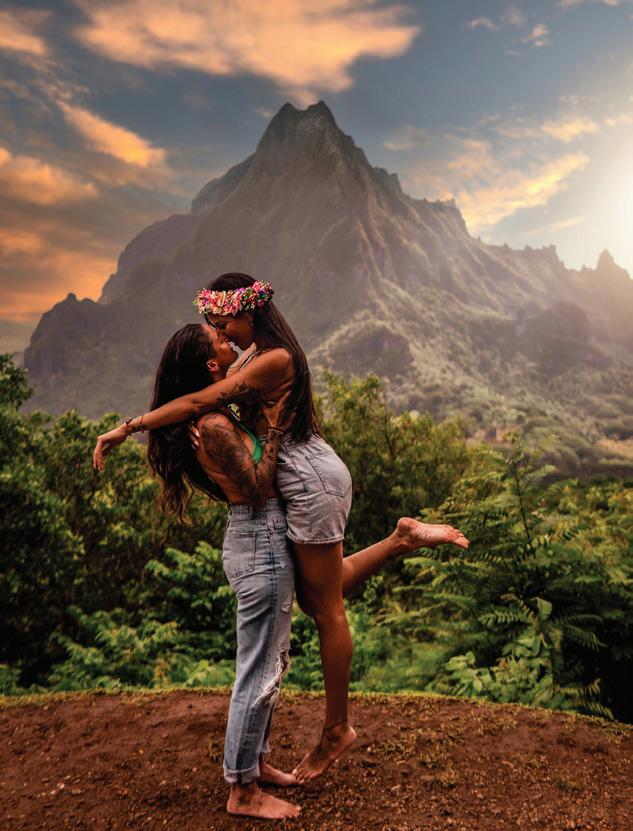
Flytographer. “She made us feel safe and welcome— we couldn’t have asked for a better experience.”
In addition to traveling to more destinations, Pike and Diaz want to take On Airplane Mode on the road through events, workshops and masterclasses, where people can learn more about LGBTQ+ travel and network beyond the digital experience, and launch a podcast “to share a side of us that has not been seen before on a more personal and unfiltered level,” Diaz says.
“On Airplane Mode is more than just a travel platform,” Pike adds. “It is a vibrant community that celebrates diversity, inclusion and the freedom to love whoever you want and be the most authentic version of you.”
150

“O ke aloha ke kuleana o kāhi malihini” - Love is the host in strange lands.
In old Hawai‘i, any person passing by was greeted and offered something to eat, whether you knew them or not. It is through these selfless, unconditional acts of aloha that we can be a part of the change we wish to see in our world today.
TEXT BY BRANDON IKAIKA BERNALDES
IMAGE BY TAYLOR CULLEN
A HUI HOU
Until we meet again

































































































































